REMEMBERING CHONG BOO HAW

19 November 1943 to 18 July 2024
The very moment the Faith wafted over Chong Boo Haw, he said he was already a believer. In accepting the Faith, Boo Haw was not aware that his fate was to play great roles in the Faith. At the very early stage itself he had understood the essence of the mission of Bahá’u’lláh and exerted all his energy to promote the Cause, making Bahá’u’lláh the very centre of his life and the meaning for his existence on this earthly plane. Although promotion of the Faith through music is widely held as his main path of service, this story brings to the fore the manifold areas of excellent services he had rendered, often without publicity. This story serves as a heart warm tribute to his uninterrupted and selfless service that was carried out with so much love, intensity, dedication and sincerity.
Boo Haw studied in the Iskandar Primary School and continued his studies in the Sultan Abdul Hamid College. After completing his Malaysian Certificate of Education in 1961 he went to a teacher training at the Malayan Teachers’ College, Penang from where he graduated in 1964. While there he was told by a friend of a group of ladies visiting the meeting hall to teach the Bahá’í Faith. He asked the friend what the Bahá’í Faith was all about, to which he replied, “They said all religions are the same and come from the same God”. On hearing this statement, Boo Haw immediately remarked, “Then I am a Bahá’í.” Later that year, when he came home to Alor Star town for a holiday, he heard that two of his best friends and schoolmates, Yin Hong Shuen and Teh Teik Cheow had become Bahá’ís. Boo Haw and Teik Cheow cycled everywhere together. Boo Haw would cycle all the way from Kampong Perak to Tek Cheow’s house in Bakar Bata and vice versa.
He taught at Sekolah Menengah Darulaman after completing his teacher training in Penang in 1964. Then he taught as a temporary teacher in the Sultan Abdul Hamid College after he taught in St. Michael’s School. It was while teaching in the Sultan Abdul Hamid College that some teachers in the staff room were talking about a new religion that was sweeping through from Alor Star to Anak Bukit. Boo Haw asked Teh Teik Cheow for some Bahá’í books to read. He lent Boo Haw “Release the Sun” and that got him hooked. After reading a few more, he began following Teik Cheow to Bahá’í firesides. He started his teaching profession at the Sultan Abdul Hamid College. It was here that he signed the Bahá’í declaration card in the teacher’s quarters of Mr. S. Nagaratnam. That was on 22 February 1966. In accepting the Faith in 1966 he said, “Some are born Bahá’ís; some found the Faith; the Faith was awarded to me!” Boo Haw was not to be an ordinary believer. Fate had bigger roles for him in the Faith.
METEORIC RISE
Having understood the mission of Bahá’u’lláh only too well at the very early stage of his Bahá’í life, Boo Haw set his mind to do his very best for the Faith. One of the early activities was to get involved in artistic talents. In 1966 the Alor Star Bahá’í community organized large scale Naw-Rúz celebrations. Boo Haw played the part of Julius Caesar. There are a few factors that led him to become strengthened in the very first year of the acceptance of the Faith. By nature, Boo Haw was an avid reader and laid hands on any Bahá’í literature that was available to him. He was surrounded by a dynamic set of believers who were on fire with the love of the Faith. He had exemplary elders like Mr. S. Nagaratnam and Mr. Phung Woon Khing who constantly instilled in him vitality through their deepening sessions. More importantly in 1966 itself he was very privileged to have attained the presence of Hands of the Cause of God Dr. Raḥmatu’lláh Muhájir and Mr. Ṭarázu’lláh Samandarí, whose words, advice and guidance created deep impact within his soul.
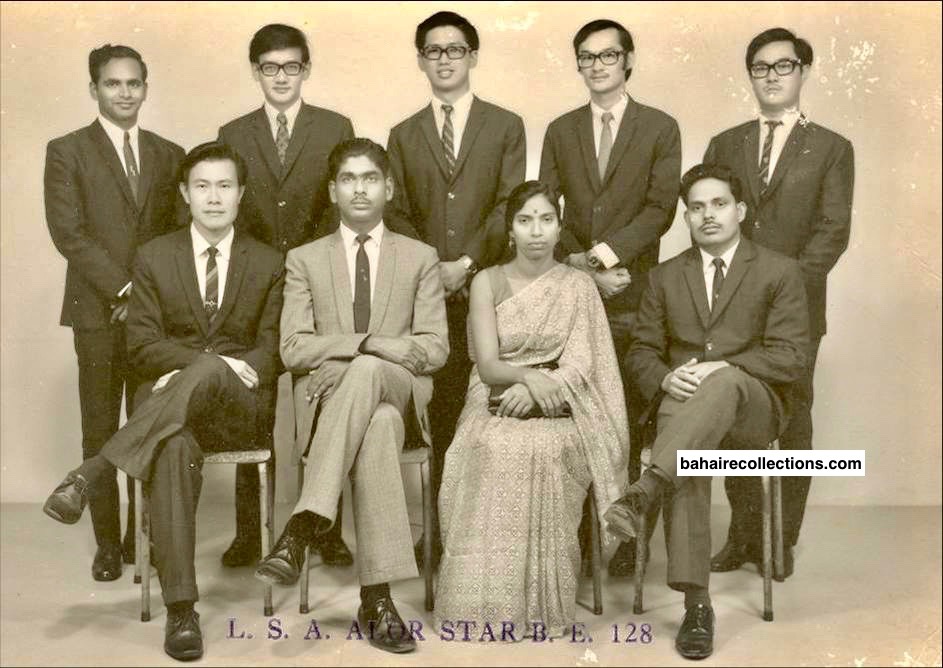
Local Spiritual Assembly of Alor Star, B.E. 128. Standing L-R: Ganasa Murthi, Tan Boon Tin, Chong Boo Haw, Teh Teik Hoe, Teh Teik Chow. Seated L-R: Mei Siew Hong, S. Nagaratnam, Sarveswary and M. Subramaniam. Boo Haw was the longest serving member of this august institution.
MARRIAGE AND PROCLAMATION
In 1969 an important proclamation event took place with the marriage of Chong Boo Haw to Lim Swee Geok @ Lim Siew Gaik. On the afternoon of 23 December 1969, he organised a pre-marriage lunch for his father’s business friends; at 4:00 in the evening was the Bahá’í Wedding with a Tea Reception; and at night was a grand dinner hosted for all, where among others, Dr. Mahathir bin Mohammad, the fourth Prime Minister of Malaysia and his wife Dr. Siti Hasmah attended. A few Bahá’ís had known Dr. Mahathir in person, but in all probability this was the first time he had come for any official Bahá’í function. That was said to be the wedding of the year in Alor Star with more than 700 attending. There was good coverage in the press. The father of Boo Haw, Mr. Chong Boon Hoo bought over from Mahathir an Opel Kadet car with registration number KA 4066 and gave it to Boo Haw in 1970. It was this car that went to many parts of the country for teaching activities. Chong Boo Haw himself had cultivated excellent public relations qualities that enabled him to create inroads for the Faith in many upper echelons of society, including royal families.

Bahá’í Wedding. Lim Siew Gaik signs on the Marriage Certificate, with Boo Haw standing at left. In the middle is S. Nagaratnam. To the left are Mr. Mei Siew Hoong and Mrs. Rajambaal Nagaratnam.
After his marriage, Boo Haw would organise large scale Bahá’í gatherings at their first home together (1969 to 1982). This was a popular attraction for the youth who would gather to have deepening, firesides, singing, games and meals. This home hosted warm and delightful hospitality for believers who came from as far as Johor Bahru, Kuala Lumpur, Penang and even South Thailand. Naw-Rúz open house and some holy days were celebrated on grand scale. Youth from Penang would drive just to enjoy conversation with Boo Haw and his wife, and to play indoor games, such as chess, and then return after some deepening sessions. Knowing Boo Haw and his wife, Siew Gaik as she was known by, the Bahá’ís would find it most comfortable in dropping by as a surprise to them. There was a stream of visitors even at the late hours of the night, just to be in his radiant company. His house was a sanctuary to all visiting believers from all over the country. Bahá’ís from abroad or pioneers visiting Alor Star were also invited to give talks at his home. Interestingly Tan Boon Tin accepted the Faith on the evening of 17 August 1970 at this home when Miss Anita Graves, a visiting Bahá’í from the United States gave a talk. The warm and open house as well as the same kind of activities continued when they moved to another house within the neighbourhood. In the later years Study Circles and Devotional gatherings which were part of the core activities were held here. It was in this blissful atmosphere of hospitality that Boo Haw formally and informally deepened the believers. This role become more prominent especially after the early believers of Alor Star had been transferred to other communities or had passed away. Boo Haw was the last remaining believer belonging to the old batch.
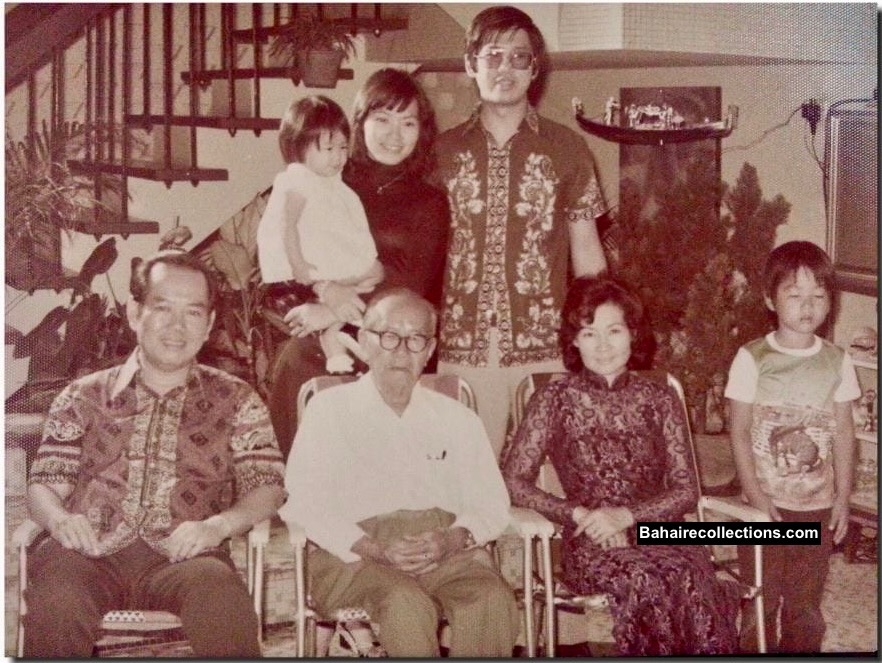
Family of Boo Haw and Siew Gaik. Standing L-R: Siew Gaik carrying Shermaine and Boo Haw. Seated L-R : Mr. Lim Pee Kee, father of Siew Gaik, Mr. Lim Heng Guan, grandfather of Siew Gaik, Mdm. Lee Poh Tin, mother of Siew Gaik, and standing at the extreme right is Zohrab.
CAREER
In 1968 he joined the Central Finance Company as a Finance Manager. He employed two believers- first Miss Teh Hong Lye and Tan Boon Tin in 1974. After the Central Finance Company, Boo Haw joined his father and brother in the Unirite Insurance Agency before it changed name to Insbruck in the later years. Unirite had its head office in Penang. Boo Haw was based in Alor Star but went only for meetings in Penang. After that he worked as Branch Manager at the Pacific Insurance in Jalan Putra, Alor Star before moving on to Multi-Purpose Insurance, Alor Star branch, until he retired after a period of more than thirty years. Throughout his career, Boo Haw cultivated an extensive network of contacts, allowing him to continue offering invaluable advice and services to his clients until 2019, when he began experiencing memory decline.
Over the years, Boo Haw was blessed in establishing himself financially. He had ventured into small property development of a few bungalow lots in Alor Star. He also joint ventured into a marine barge shipment to Langkawi for a short period of time. When the City Point Shopping Complex in Alor Star was completed, he secured a small space in a corner of the Complex on the ground floor, with the assistance of the Mayor (Datuk Bandar) of the City Council. He started his café called “Hot Rock Café ” for some five years, selling nasi lemak, ice cream, coffee and other titbits. This café was so successful that he even gave employment to the late Mr. Mei Siew Hoong to manage his café. After Mr. Mei Siew Hong, Boo Haw employed Mr. Arumugam, son of the late Mr. Doraisamy of Jabi Estate. When his lease period ended, Boo Haw had to close the business.
Well blessed with financial strength Boo Haw was known for expending his fortunes on his family and the Faith. He lived a moderate life although he could have easily led a princely kind of life. Whenever any call or request came in the interest of the Faith Boo Haw never hesitated to help out.
ADVISOR TO YOUTH
In the 1970s it was Chong Boo Haw who was advisor to many individuals, as well as the Local Bahá’í Youth Committee of Alor Star town. He could give motivating talks. At the State Level Bahá’í Conference held in Sungei Petani he spoke on the role of the youth in the Bahá’í community and quoted copiously some heroic stories from the Dawn Breakers. One of the well -remembered statements was, “The adults are like the bow while the youth are like the arrows. The adults, like bows give you the push while it is the youth who, like the arrows will hit the targets”.
One of the goals set by the National Bahá’í Youth Council for the youth under the Inter -Youth Competition was the contribution of stamps. These stamps were sent to the National Spiritual Assembly, which needed them in abundance to post thousands of letters. The winners of the stamp competition in 1971 were the Local Bahá’í Youth Committees of Alor Star, Ipoh and Kuching. In 1971 the National Bahá’í Youth Council started a poster competition, which was won by the Local Bahá’í Youth Committees of Alor Star, Penang and Kuala Lumpur. When the National Bahá’í Youth Council introduced the Rose of Ridván Challenge Trophy in 1971, it was the Youth Committees of Alor Star and Glendale Estate in Negeri Sembilan that shared this coveted prize. The Alor Star youths won it again in 1978 and once more in 1980 (with the youth committee of Kuala Pilah).
In 1985 he trained a youth group made up of 16 members from across Malaysia to organise a musical tour to perform in Thailand. The group was made up of among others, Ambigaibalan, Judy Phung, Sashi Kumaran, Shobana, Lena Leong, Bernard Yeoh, Kim Siew Yen, Mehran Chinniah, Saffura Chinniah, Zohrab Chong, Kavi Rao, Sri Balaranga and June Teh. Once they reached Thailand the local program was coordinated by Mr. Kanna Baran, a Malaysian pioneer to Indochina. They performed in Hat Yai, Bangkok, Yasothon and Chiang Mai. In Bangkok they performed at the American Business English Centre and the Chulalongkorn University. In Chiang Mai they sang along the main riverside at as part of the year end festivals. They also gave radio station interview and recorded a video clip in one of the local television studios. Boo Haw did not follow them but was proud to learn of the resounding success of the group that he had trained. Throughout his stay in Alor Star Boo Haw was the mentor, drill master and driving force for the youth.
REAWAKENING
Although Boo Haw was already confirmed in the Faith at the time of his acceptance in 1966, by his own accounts the real transformation came about at the First Winter School of Malaysia held in Johor Bahru in December 1972. That was his momentous occasion when he woke up from the realisation of his blindness. The Winter School focused deeply on topics such as Universal House of Justice, Kitáb-i-Aqdas and the Hidden Words. The film “Lamp Unto My Feet” was screened for the public after a public talk at the Diamon Jubilee Hall. This conference had a tremendous impact on him. When Teh Teik Hoe and T. K. Lee were pioneering in Hong Kong, Boo Haw wrote a letter to Teik Hoe of a realization that came upon him after attending the Winter School. Part of that letter dated 20 January 1973 reads, “At the Winter School I “saw” (inner eye) the Faith matured and crystalized. I can’t explain it but there was a new mood in the air for sureness, confidence and just plain bliss. Many of us had found Bahá’u’lláh in our hearts at last! We had been intellectual Bahá’ís all along. We found Him upstairs but not inside. Well now I feel that after six years as a Bahá’í I have finally crossed the Valley of Search and am now blissfully walking in the Valley of Love, love for God that is. ‘Abdu’l-Bahá says only the Valley of Love is reality. The love between man and woman is subject to transmutation. I am slowly beginning to understand. I believe you and Richard (T.K. Lee) had long passed the first Valley or else how could you pioneer? That is why I envy both of yo…”
Buoyed by the inspiration Boo Haw received at the Winter School he stepped up both his commitments and activities at the local and national fronts.
TEACHING AT THE LOCAL LEVEL
Boo Haw was a dedicated field worker from the very beginning, known for his goal-oriented approach and unwavering focus on achieving the objectives set by the national institution and the Kedah State Teaching Committee. The Bahá’ís of Alor Star would drive down to the estates around Central Kedah State to visit and deepen the believers. Among those who undertook this task were Chinese speaking believers such as Chong Boo Haw, along with Yin Hong Shuen, Teh Teik Cheow, Tan Boon Tin, Teh Teik Hoe, Phung Woon Khing, Peter Chew Huat Chin and Mei Siew Hong. These Bahá’ís, without the knowledge of the Tamil language created an impact among the rubber plantation settlement (estate) workers who were pleasantly surprised to see Chinese visitors.
They would drive down to Sungei Petani and take along the local Bahá’í s of Sungei Petani to do estate teaching in various parts of Kedah. Boo Haw was one of those who went for estate teaching. Apart from teaching trips to the estates he also attended Bahá’í weddings. Kulim town was a difficult place in the early 1970s, and Boo Haw joined other believers of Alor Star, Glugor and Georgetown in Penang in visiting the community for consolidation. In 1972 the Kulim believers were able to rent their own Bahá’í centre.
In 1972 he was appointed into the Area Teaching Committee of Kedah, and he had to undertake several teaching trips in this state to win the goals of the National Spiritual Assembly assigned to this region. Boo Haw was always goal oriented in his teaching efforts.
He organised personal teaching trips to difficult areas such as Kelantan state, paying for all expenses. In one trip to Kelantan by two carload of believers, Boo Haw had with him all the Bahá’í contacts in the state of Kelantan and met almost all of them. When meeting them he presented them with Bahá’í gifts such as prayer books and other Bahá’í books. He did not spare the Aboriginal (Asli) villages as well.
He carried some Bahá’í pamphlets with him started conversation with fellow passengers and when opportunity presented itself he would present the Faith. Whenever someone arose to teach the Faith, Boo Haw was very supportive and provided every possible assistance. At times when he could not undertake teaching trips, he would subsidize them. In 2019 Dr. Firaydun Mithaq passed through Alor Star on his way to Padang Lembu Estate where he wanted to teach the Cause. Since he planned to stay for about four months, he asked Boo Haw to assist him in renting a car. But Boo Haw gave his own car with which Firaydun was able to drive around and teach the Cause and deepen the believers in Padang Lembu Estate. During these four months Firaydun alternated between his home in Chiang Mai and Padang Lembu Estate.
TEACHING TRIPS ABROAD
The Bahá’ís of Alor Star continued to maintain intimate connection with South Thailand even in the 1980s and beyond. The National Spiritual Assembly of Thailand and Malaysia worked out a joint program to assist in the development of the Faith in South Thailand. The official South Thailand Border Teaching Committee was formed in 1967, an idea emanating from the brilliant mind of Hand of the Cause of God Dr. Muhájir. This committee took different names over the years. In the 1980 it came to be called the Border Teaching Committee, supported by the Regional Teaching Committee of South Thailand and several assemblies in West Malaysia. Chong Boo Haw, Teh Teik Hoe and M. S. Maniam of Alor Star, Wong Boon Tok of Kangar, Chew Beng Cheong of Penang and Vijayan Joseph of Butterworth were on this Committee. Chong Boo Haw himself was Chairman while Vijayan Joseph was Secretary of this committee for several years. They met once in a month at the residence of Victor Greenspoon in Hat Yai to plan out their activities. Members of the committee were assigned different places in South Thailand. Chong Boo Haw was assigned Pattalung and Yasathon, while Teh Teik Hoe was assigned Phuket. Yet when these valiant soldiers went for teaching, they took along others as well. Among them were Liu Man San and Doreen, Thomas Siew, Leong Foo Cheong. Nagendran from Kuala Lumpur too joined Boo Haw from time to time in spreading the Cause in South Thailand. The non-working youth were usually broke, but the adults especially Boo Haw would take care of their expenses. Their activities included teaching in the streets and in villages, singing in the parks and beaches, making bold presentation in universities and teacher training colleges.

Official opening of the new Bahá’í Centre at Bangkok on 26 November 1998. L-R: Wong Boon Tok. Mrs. Chusiri, Sukhum Abhasakun Faridian and Boo Haw.
In early 1980 the Supreme Body requested the Malaysian Bahá’í community to provide assistance for the development of the Faith in Burma (Myanmar). Several individuals arose to answer the call. In the early 1980s Boo Haw booked two air tickets- one for himself and the other for his friend Leong Foo Cheong and arranged visas for both to answer the call of the Supreme Body. They both went for travel teaching in Myanmar for a week. Apart from Rangoon, the went to ‘Abdu’l-Bahá’s village in Daidanaw as well. Boo Haw told many stories to inspire the believers, and his guitar was there to boost their spirit. Boo Haw and N. S. S. Silan went to Myanmar in 2016 and joined in the youth gathering held in the Bahá’í Centre in Yangon.

Youth gathering at Yangoon, Myanmar, 2016. Boo Haw is seated in the centre, on the floor. N. S. S. Silan stands at the extreme right.
In 1987 he went to Papua New Guinea for travel teaching and to meet up with his old friends like Leong Ho San, Tan Keat Fong and N.S.S Silan. He was taken to meet the believers in Port Moresby and some village communities. In the two weeks Boo Haw was in Papua New Guinea, he cheered the friends through strumming his guitar and telling some Bahá’í stories.
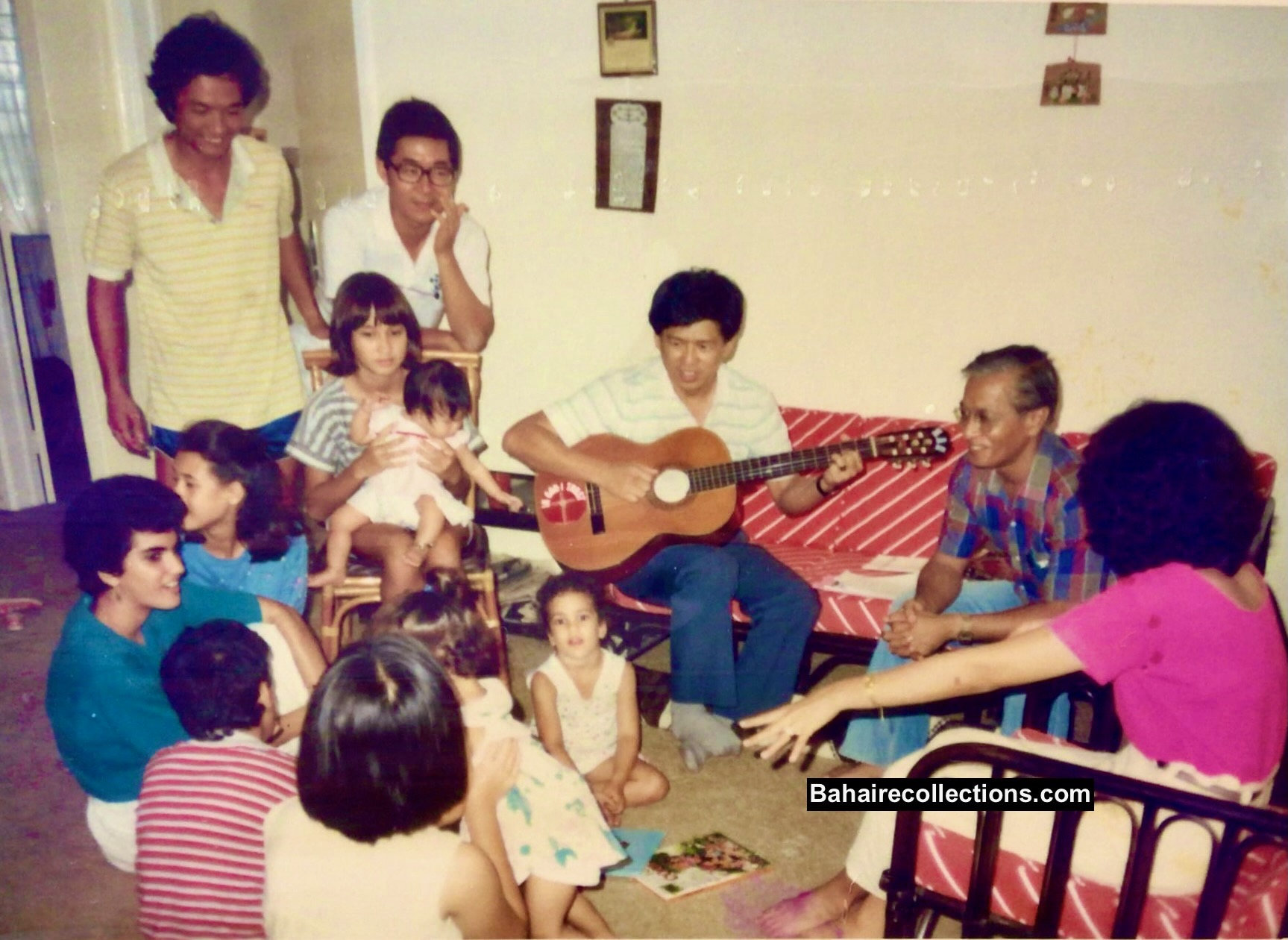
Boo Haw plays guitar during his visit to Papua New Guinea in October 1987. Leaning on a chair at his back is Tan Keat Fong.
Boo Haw was known to make sudden decisions to undertake sudden teaching trips. One of such trips was undertaken to Chiang Mai in 2021. He took his wife, and David Soo, a believer from Butterworth for a teaching and consolidation visit to Chiang Mai in Thailand where they stayed in the home of Dr. Firaydun Mithaq, a pioneer from Iran to Laos since 1982 but settled in Thailand. In this one-week trip, Firaydun took them to visit the community, meet individual believers and teaching as well. Even in his last days when his health was deteriorating, Boo Haw pulled along Leong Foo Cheong for street teaching in Hat Yai, South Thailand.
DEEPENING CLASSES
As an avid reader, Boo Haw was well conversant not only in the Bahá’í Faith, but on the subject of comparative religions as well. He became highly knowledgeable in Christian subject. Not that he wanted to master this subject, but some situation forced him to throw himself into mastering Christianity. In about 1966 Boo Haw was courting Miss Lim Swee Geok @ Lim Siew Gaik, whom he was to marry later. As she was a staunch Catholic, Boo Haw went deep into studying the Bible to convince her on the return of the Father. In the course of this effort, he mastered the Book and later conducted in-depth study classes on the subject of Christianity and the Bahá’í Faith, to the astonishment of the participants.
He was constantly in touch with the Bahá’í bookshop in Kuala Lumpur and purchased the latest on the shelf. Whenever one conversed with Boo Haw on any subject, he not only had the ability to quote the books but would give complete and convincing answers. He had great analytical mind.
His depth in the Holy Writings came to the fore at the Kedah Peak retreat held from 25 to 27 July 1971 when twenty believers were gathered. When Boo Haw spoke on the Writings the believers listened to him wrapped in full attention and delight.
MUSICAL BOO HAW

The Stellar Performer Boo Haw.
We have ample statements in the writings pertaining to music. Bahá’u’lláh says in The Kitáb-i-Aqdas, “We, verily, have made music as a ladder for your souls, a means whereby they may he lifted up unto the realm on high . . .” ‘Abdu’l-Bahá asserts that “music, sung or played, is spiritual food for soul and heart.” The Beloved Guardian has said, “It is the music which assists us to affect the human spirit; it is an important means which helps us to communicate with the soul”. Boo Haw was well endowed with music talent- one of the gifts of the Holy Spirit and has used this talent predominantly, or even fully for the Cause. His affinity for songs was rooted in his intuitive understanding of music. As years rolled by, he became an iconic figure as a roving ambassador in the promotion of the Faith through music. He became a household name in Malaysia in entertainment of gatherings through his songs and guitar. He truly established himself as the quintessential singer.
In Malaysia, the first musical fireside was organised by the Bahá’ís of Bagan Serai in the year 1966. The Bahá’ís of Bagan Serai purchased musical equipment and held a musical fireside at Sungei Gedung Estate. That was short lived. This format of teaching through music took a serious note in 1970 with the youth of Alor Star and Penang teaming up to form the Malaysian Bahá’í Musical Group.
Boo Haw was a talented musician from schooldays. Along with music his other extraordinary talents too blossomed in those tender years and showed up in greater proportions in later years. During the early 1960s Boo Haw would go to the house of the brothers Teh Teik Cheow and Teh Teik Hoe, sometime bringing his record of the Everly Brothers. He would play his record and the three would listen and sing together. Coincidentally Teik Hoe and Boo Haw would pair up as singers. In stages Boo Haw became a collector of albums such as Everly Brothers, Simon and Garfunkel and Seals and Crofts. The early 1970s was the time when a new attempt was made to convey the Bahá’í Teachings in a different format altogether- though music.
In August 1970 the famous Alor Star Youth Choir which later became The Alor Star Bahá’í Choir had its genesis at the back portion of Central Malaysia Finance office where Boo Haw worked. After office hours Boo Haw would gather a few singers to practice songs made popular by Bahá’í composers from America like the late Russ Garcia of the Bahá’í Victory Chorus fame. The members of the choir were Chong Boo Haw, Teh Teik Hoe, Remala and Nirmi Nagaratnam, Kamachee, Teh Hong Choo, Ch’ng Suan See, Tan Boon Tin, and Chandrasegaran. Boo Haw and Teh Teik Hoe were both singers and guitarists who wrote lyrics and composed music. The Alor Star youths were the first to print postcard with a photograph of a Bahá’í choir in action. Chong Boo Haw has always been called the “Elvis Presley of Malaysia” for his artistic talents in the field of singing. He could simply impersonate him to the very walk. In no time Boo Haw had taken on an iconic status in the singing circle both locally and abroad.
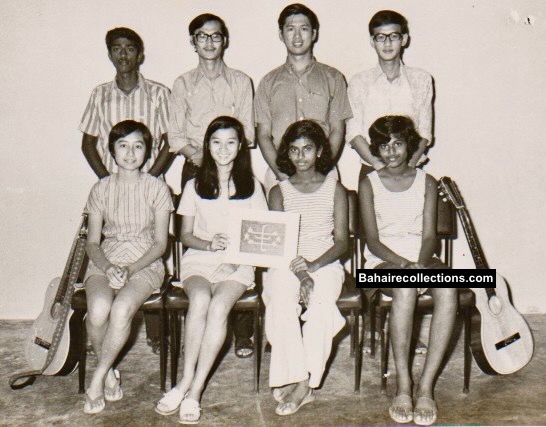
The budding Alor Star Bahá’í Choir, 1971. Seated L-R: Ch’ng Suan See, Teh Hong Choo, Remy and Nirmy. Standing L-R: Chandrasekaran, Teh Teik Hoe, Chong Boo Haw and Tan Boon Tin.
In 1971, the Alor Star Bahá’í Choir produced a songbook called “Sing Out Bahá’ís.” It cost only RM 2.00 per copy. Whoever wanted the 30 songs was requested to supply empty audiocassettes to the Alor Star Bahá’í Choir. Tan Lee Soo Hock of Penang, Chong Boo Haw and Teh Teik Hoe of Alor Star composed original songs. These songs were also recorded in cassettes and distributed. A number that was collectively composed by Chong Boo Haw and Tan Lee Soo Hock was called “Matchless Day.” The songs that Boo Haw composed himself were “Covenant”, “The Apple Falls”, and “Quest for Peace”. The “Apple Falls” is a song that talks about the proof of existence of God, which was composed with soul-touching lyrics after listening to a recorded talk by the Hand of the Cause of God Mr. Abu’l-Qásim Faizí. When David Garcia, son of Russ Garcia visited Malaysia in 1979 he assisted in creating further taste for music.
When Teh Teik Hoe and T. K. Lee were pioneering in Hong Kong, Boo Haw was a sad man. He too wanted to join them but his commitment to his father’s tasks did not permit him. Yet he looked out for some opportunities elsewhere. N.S.S. Silan of Petaling Jaya who was pioneering in Kenya, Africa invited Boo Haw to join him in Africa. Boo Haw immediately wrote a letter to Teh Teik Hoe on this matter. Part of that letter dated 20 January 1973 reads, “Silan has written two more letters. He is top form there. Full of wit too. Wish I were there with him. He says Africa needs singers and with his singing (you know his singing!) he is in top demand! How about you and me going there? I am desirous. Think about it. Meditate on it and then tell me.”
The real turning point of the Alor Star Bahá’í Choir was in 1973. In December 1972 Boo Haw was singing at the Winter School in Johor Bahru to standing ovation. His hit song was “Go Ye Forth” a song that was originally composed by Teik Hoe. Inspired by this Winter School, Boo Haw started writing more songs upon returning to his hometown Alor Star. He was cyclostyling a new song book and planning to come out with a new song book. He was planning to buy a new guitar and cutting a new album as soon as Teik Hoe returned from Hong Kong. While Boo Haw was composing some songs on his own in Alor Star, Teik Hoe too was doing the same while in Hong Kong. When Teik Hoe returned from Hong Kong in 1973, these two teamed up to strengthen the Alor Star Bahá’í Choir. They joined hands and composed more songs in Alor Star. Over weekends they would visit the Penang Bahá’í Choir to give a helping hand and exchange notes. It was in 1973 that the Alor Star Bahá’í Choir led by Boo Haw and Teik Hoe teamed up with the Penang Bahá’í Choir and became known as the Malaysian Bahá’í Musical Group. All along they were having localised musical events.
 Musical fireside in Alor Star Bahá’í Centre, 1973. The performers L-R: Boo Haw, Tan Gaik Bee, Susheel Sundram, Christine Soon and Teh Teik Hoe (Photo Courtesy: Teh Teik Hoe)
Musical fireside in Alor Star Bahá’í Centre, 1973. The performers L-R: Boo Haw, Tan Gaik Bee, Susheel Sundram, Christine Soon and Teh Teik Hoe (Photo Courtesy: Teh Teik Hoe)
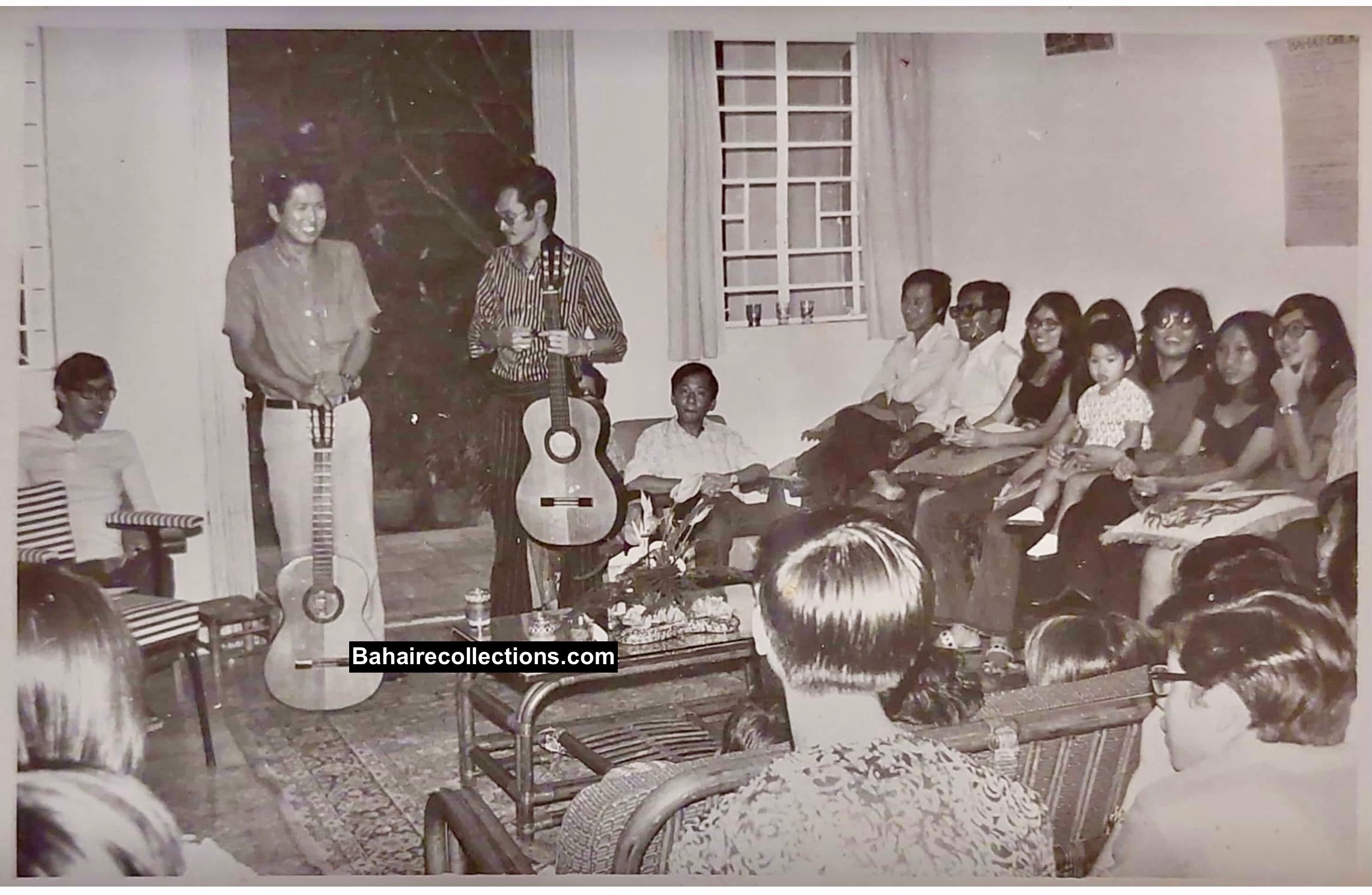 Musical Fireside held at the residence of Lily Jansz in Penang, 1973. The two Alor Star believers with guitar are Boo Haw at left and Teik Hoe at right. (Photo Courtesy: Teh Teik Hoe)
Musical Fireside held at the residence of Lily Jansz in Penang, 1973. The two Alor Star believers with guitar are Boo Haw at left and Teik Hoe at right. (Photo Courtesy: Teh Teik Hoe)
Then came the next leap. This group performed on a larger scale for a larger audience at the St. John’s Ambulance Hall in Ipoh town during the Summer School in July 1973. The musical fireside was repeated at the National Bahá’í Youth Conference at Port Dickson in December 1973. Close to fifty from the audience accepted the Faith at the performance in Port Dickson, and manpower was immediately needed for consolidation. The author volunteered to consolidate them. There were several performances in Seremban, Singapore (in conjunction with the Winter School held at the Tanah Merah Holiday Camp from 26 to 29 December 1974, and another public performance also held at the Mac Ritchie Park after the Winter School, Petaling Jaya, Genting Highlands and Setapak in later years. In 1975 the team also went to perform in Hong Kong and Thailand, with the Thai television providing good coverage.
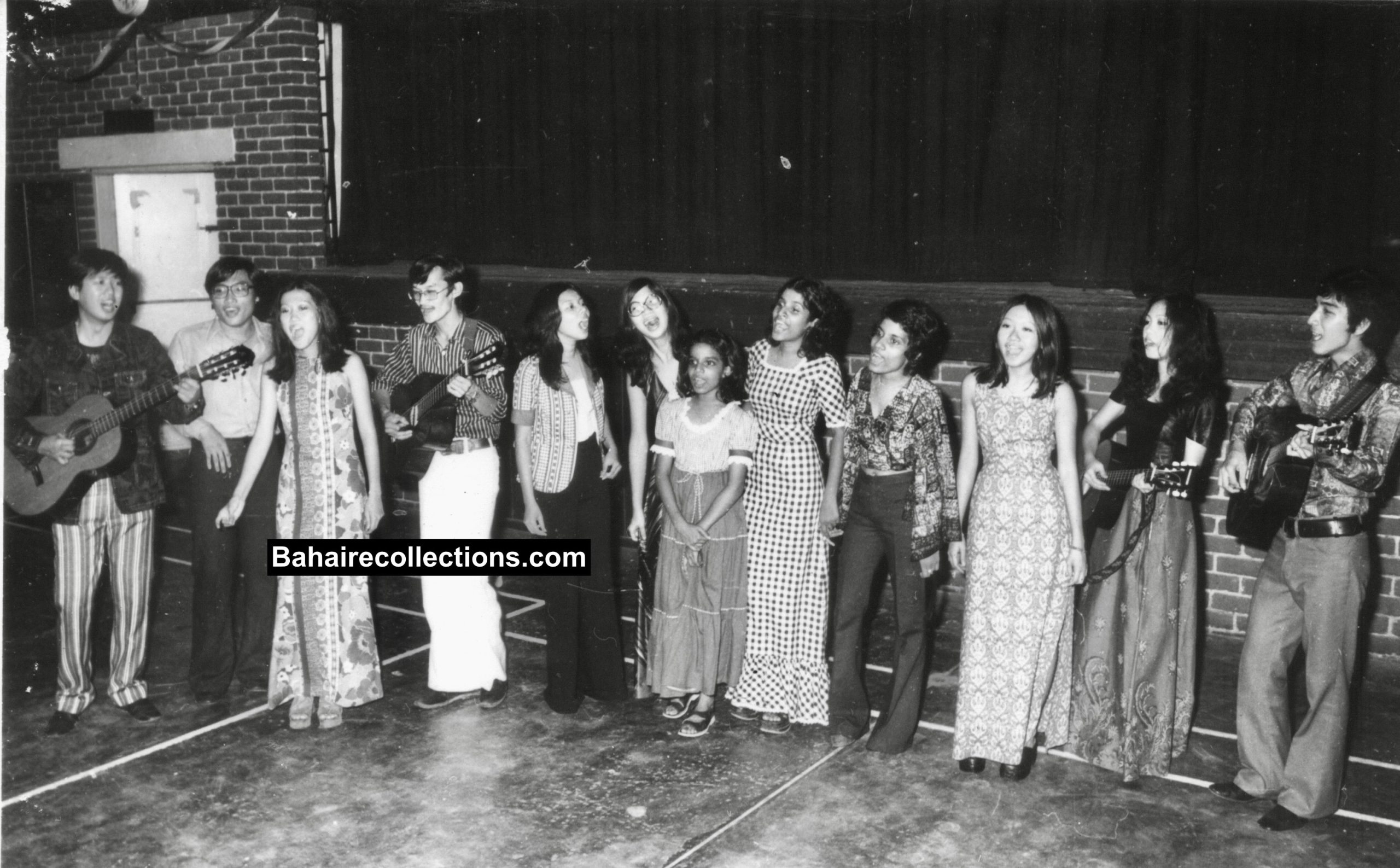 The first large scale musical fireside at the St. John’s Ambulance Hall in Ipoh town, July 1973. L-R: Boo Haw, Tan Lee Soo Hock, Shirley Kwan, Teh Teik Hoe, Lim Li Swan, Tan Gaik Bee, Malini Sundram, Susheel Sundram, Padma Sundram, Choy Voon Keng, Christina Soon and Steven.
The first large scale musical fireside at the St. John’s Ambulance Hall in Ipoh town, July 1973. L-R: Boo Haw, Tan Lee Soo Hock, Shirley Kwan, Teh Teik Hoe, Lim Li Swan, Tan Gaik Bee, Malini Sundram, Susheel Sundram, Padma Sundram, Choy Voon Keng, Christina Soon and Steven.
As the audience were the enquirers, musical firesides required a lot of practice, and they had to be professional. However, as the members of the Bahá’í Choir dispersed, there were none left to continue this form of fireside. Owing to the sensation the musical firesides had created in Malaysia and abroad many local communities started organising the same, but not striking the score of the Malaysian Bahá’í Choir Group.
At the International Teaching Conference held in Hong Kong in November 1976, different countries staged singing sessions during the evenings. The Malaysian participants already consisted of ready-made singers who were trained in the Musical Firesides. They performed the songs inviting roaring and thunderous welcome! Those in the group were, among others, Boo Haw, Jimmy Seow, and Miss Loh Lee Lee. Some singers from other countries also joined the Malaysian singers.
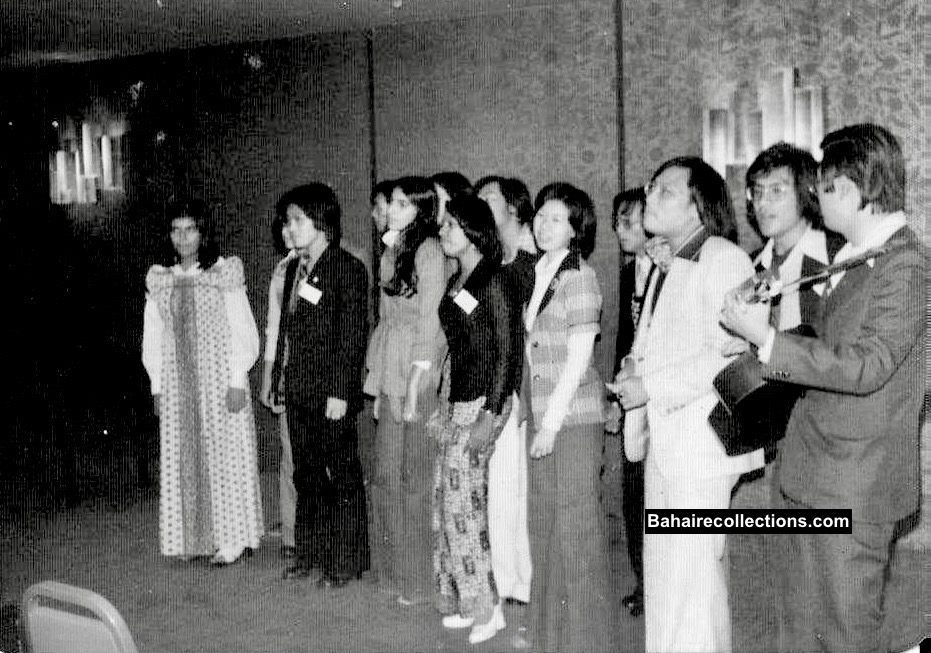
Performance at the International Teaching Conference in Hong Kong, November 1976. Boo Haw at the extreme left. To his right are Tan Lee Soo Hock (white) and Jimmy Seow at the back.

Musical Fireside in Penang, 1974. At extreme left is Jimmy Seow. Boo Haw is with guitar at the extreme right, with Teh Teik Hoe next to him. (Photo Courtesy: Jimmy Seow)
In the 1980s too music continued to permeate the lives of the Alor Star Bahá’ís. 1985 was designated the International Year of Youth by the United Nations. Malaysia then hosted a youth conference in Port Dickson. There was a bus load from Alor Star. The Bahá’í s of Alor Stare prepared a book containing 101 songs in 120 pages, with guitar chords included. Chong Boo Haw, Teh Teik Hoe, Liu Man San, Siew Gaik and Zohrab assisted in the preparation of this book. Siew Gaik typed and checked the wording at a time when computer spell check was not available. They spent many late hours at Boo Haw’s office, which was already another gathering place for the Bahá’ís, ensuring the book was ready for the event. All the 500 copies were sold like hot cakes, at a meagre cost of only 50 cents. That was about the last song book to be produced in Alor Star community. Formed and led a 200 strong voice choir at the Winter School held in Kangar, Perlis in 1998.
Boo Haw had performed ‘Elvis’ many times for the Sultan and the fourth Prime Minister of Malaysia Dr. Mahathir but the highlight of his ‘singing career’ must surely be the rare privilege of singing a duet with Dash Crofts in Penang in 1999.
When the Malaysian Bahá’í Community celebrated its Fiftieth Anniversary of the acceptance of the Faith in Malaya at Ipoh town in 2003, the Alor Star community, especially Chong Boo Haw produced CD “The Apple Falls”. It was “The Apple Falls” album that catapulted Boo Haw into great fame. There were good sales at the event, enabling all music lovers and second generation Bahá’ís to reminisce remember the role of Alor Star in the development of Bahá’í music in this community.

Cover page of The Apple Falls, the Compact Disc.
At the fiftieth anniversary celebrations of the coming of the Faith to Alor Star held at the Sentosa Hotel on 18 August 2010, Boo Haw got a large cross section of the youth to form a large choir which performed moving Bahá’í songs, befitting the occasion. At the Malaysian Winter School held in 2016, Boo Haw, Teik Hoe and Jimmy Seow reunited after singing together 40 years ago and gave a rocking performance enjoyed by more than 1,000 participants.
Boo Haw also wrote the lyrics and composed music based on the Ruhi Book on the Covenant(Ruhi Book 3.p.201) with the music arranged by Edwin Edpalina of the Australian Bahá’í Choir.
Music was synonymous with Boo Haw. Somehow, wherever Boo Haw went, he would invariably be called to strum his guitar. Apart from strumming guitar and singing at all gatherings Boo Haw attended, he also brought music to Asli villages and estate communities. When Boo Haw and Liu Man San went to Singapore in 2014 to conduct a session on the Dawn Breakers, suddenly Boo Haw was called upon to sing some songs, which he gladly did. Only those who had heard him sing the songs soulfully would have got the real and the great feel. With his stellar performances, Boo Haw was a phenomenon like no other.
TOOK MUSIC ABROAD
Boo Haw also took the music abroad. In 1989 he performed in New South Wales, jointly organised by the Bahá’í Communities of Concord, Burwood and Strathfield. This performance received extensive press coverage, and by extension publicity for the Cause. The GLEBE Daily carried the following heading in the Entertainment section, with photo of Boo Haw performing, “ELVIS OF MALAYSIA HAS HIS FANS”.
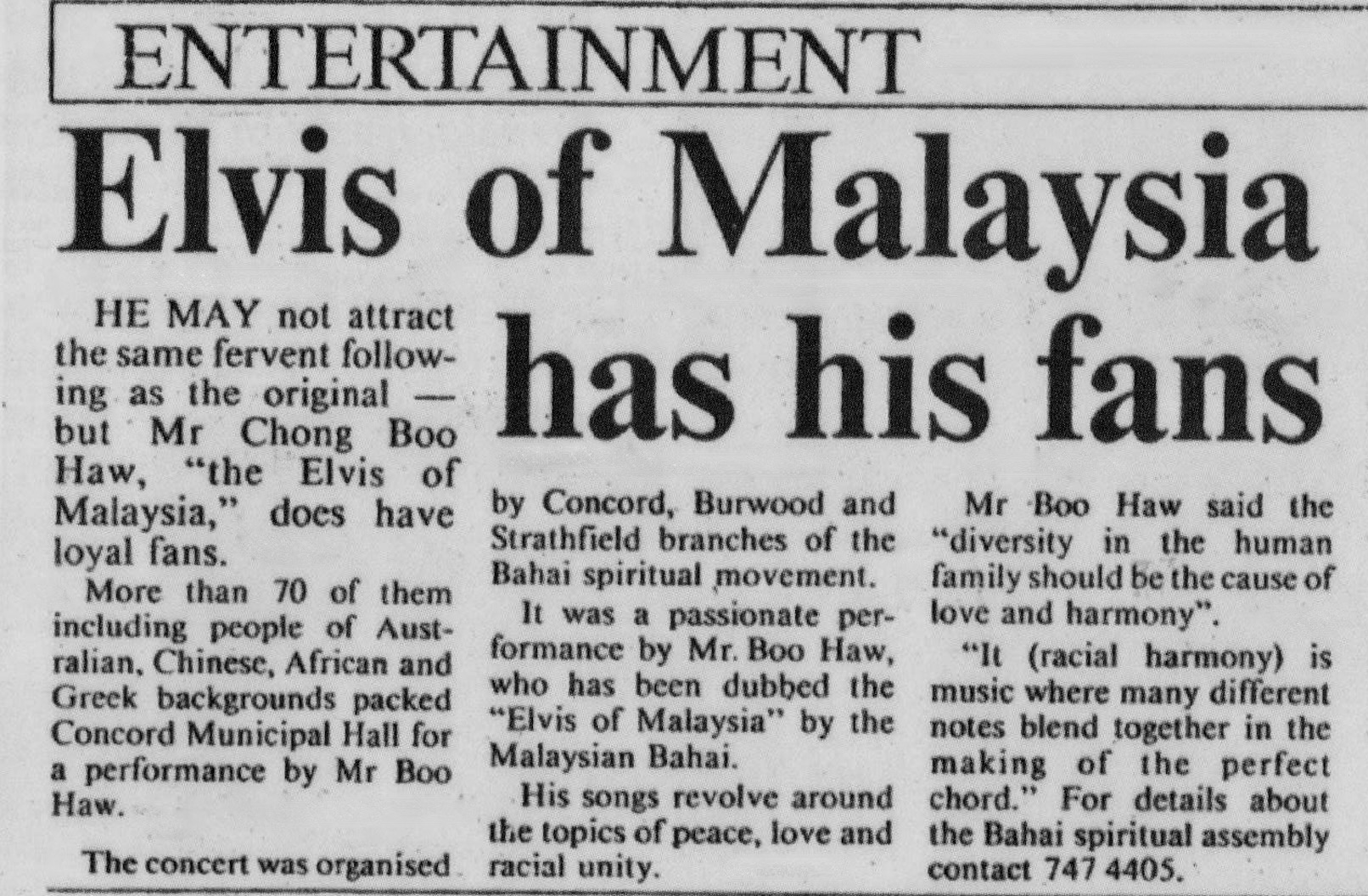
Boo Haw flashed in the news as the Elvis Presley of Malaysia.
Following the performance in the “Voices of Bahá” tour conducted by Tom Price in Penang in 1999, he followed them to perform in Singapore, Hong Kong and Macau.
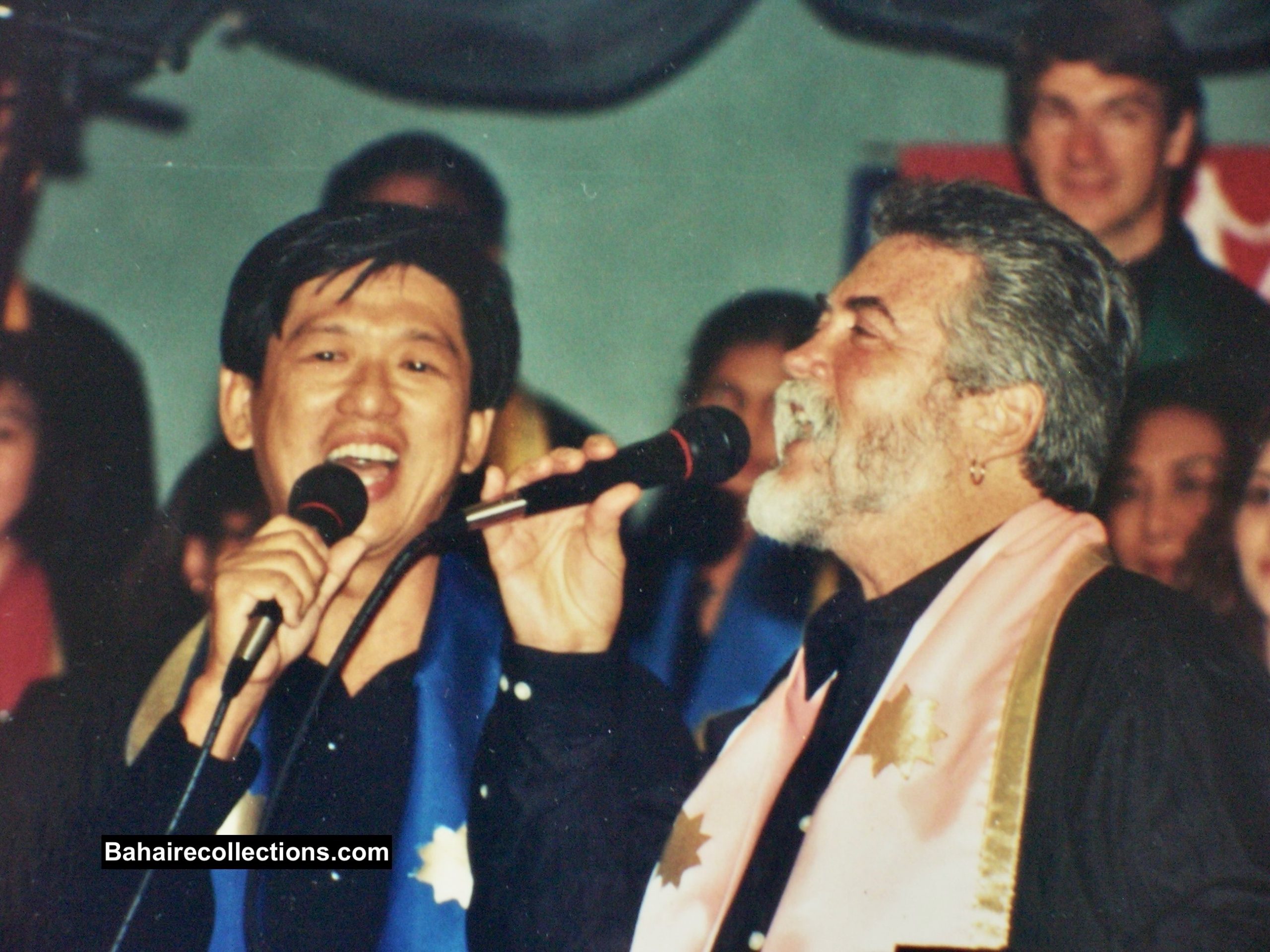
Boo Haw at left and Dash Crofts at right singing a in Penang in 1999.
In 1999 Boo Haw went to Mongolia with his own expenses to conduct training for the Bahá’í choir there. The training was held during the Summer School in Darkhan city. Member of the Supreme Body Dr. Peter Khan and his wife Janet Khan were there at the Summer School.

Boo Haw at the top left in light blue T-Shirt at the Summer School in Darkhan city, Mongolia, 1999.
Boo Haw did not confine his musical performances with the community. He was also invited or voluntarily sang with or without guitars at the events held in the Kedah Club, family functions such as birthdays of close friends, weddings of family members or Chinese New Year celebrations.
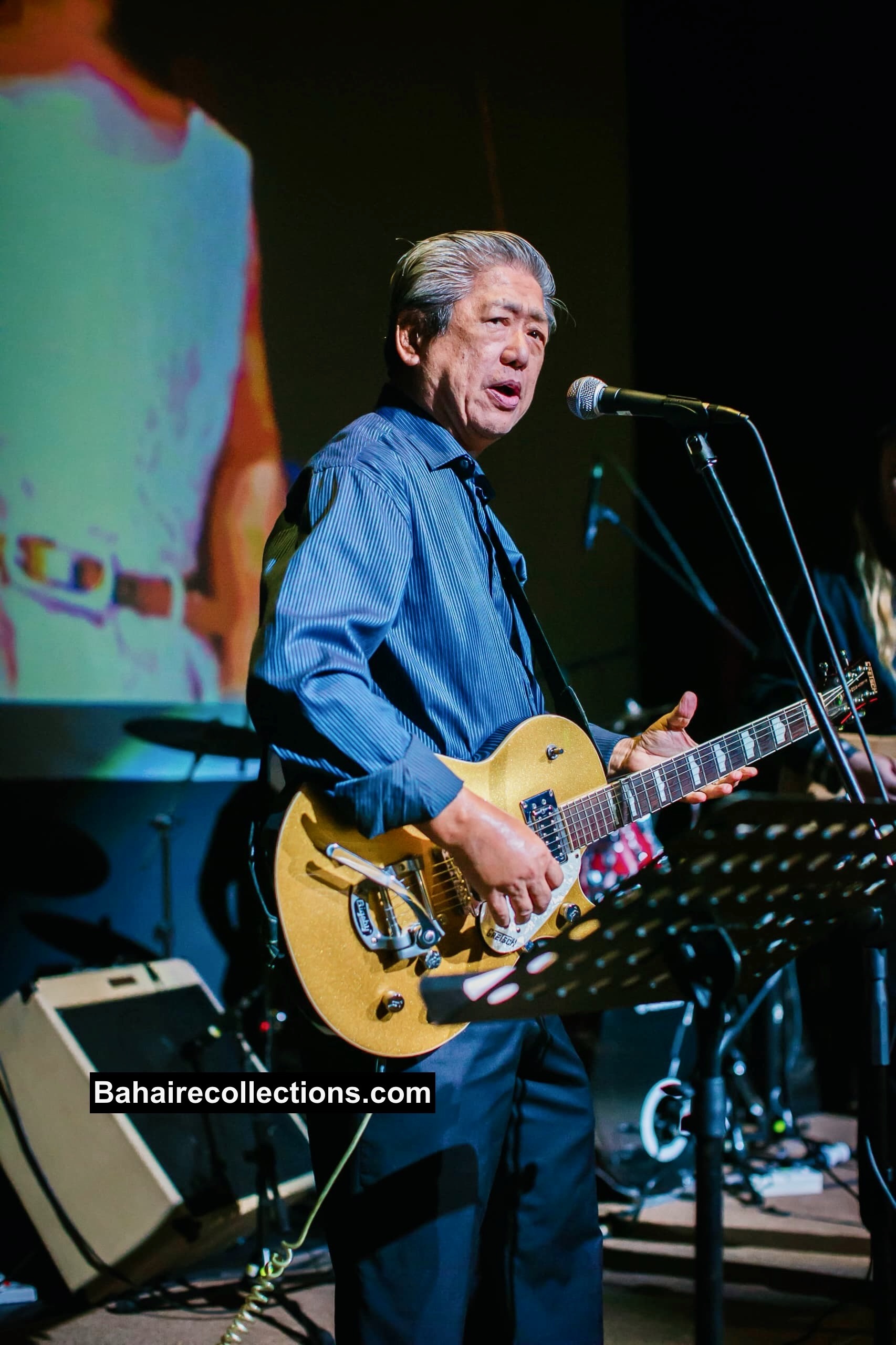
Boo Haw performing at his family function-by popular demand.
Boo Haw’s usual lively and energetic performance at the Summer School in Ipoh in December 2016.
ARTISTIC TALENTS
Boo Haw was by nature an artistic person, which he used fully for the Faith. The greatness of the man was that he got the community, especially the youth involved in all the artistic pursuits undertaken for the Cause, with the view of developing them as well.
One of the earliest efforts was the banner that was prepared to be placed on a bus that took participants for the Oceanic Conference in Singapore at the end of December 1970 Chong Boo Haw chartered a bus from Alor Star on behalf of the Area Teaching Committee of Kedah and Perlis. The banner read: “BAHÁ’Í OCEANIC CONF.” Boo Haw got the youth to join him in preparing the catchy banner, which proclaimed the Faith all the way from Alor Star to Singapore and back. It did not end there. Boo Haw was the main person who led the youth in decorating the Bahá’í Center or to give a facelift to the interiors. In early 1971 Boo Haw painted the name “Bahá’u’lláh” in Arabic style on top of all window sills in the Alor Star Bahá’í Center. When important events were coming up, especially Naw-Rúz, he would get the youth to join him in painting the walls of the Bahá’í Centre, selecting the right colours.
In encouraging the youth to take up artistic talents, Boo Haw would give talks about painters and their monumental works. In one of the talks, when the author was present, he spoke about Picasso and Michealangelo and paintings like the smiling Mona Lisa. Boo Haw was explaining in minute details on the different interpretations people gave to the paining of Mona Lisa. Boo Haw said to his effect, “Some said she was not smiling, she was just natural; some said she had eyes that had just shed tears; some said her eyes would follow you wherever you move; looking at her fingers some said she was actually pregnant; looking at the background, some said the artist was very disturbed when he was painting…” His talk was like penetrating through clouds.
The audience remained spellbound for a moment. And suddenly one excited youth shouted, “Boo Haw, Alor Star is not the place for you. Go to Kuala Lumpur which may have the proper platform for you to demonstrate your full talents”. All laughed!
THE NORTHERN STAR
Boo Haw was certainly destined to do great things for the Cause through his penmanship and drawing skills. Boo Haw had already developed his editorial skills during his Form Three days in his school. He also contributed a cartoon for his school’s annual magazine. In the Malayan Teachers’ College, he was elected editor by the Students’ Council. While working in the Finance Company, he was the editor of the “Berita SAHOCA” which is Newsletter of the Sultan Abdul Hamid College Old Boys Association.
Boo Haw wedded his drawing skills with his able penmanship in taking the lead in the production of the much celebrated and well-remembered “The Northern Star” newsletter. In July 1970, the Area Teaching Committee of Kedah/Perlis released its first issue of the newsletter called “Kedah-Perlis Bahá’í News”. At that time, it was called Kedah/Perlis BAHA’I NEWS. It was the mighty effort and hard work of Chong Boo Haw that saw the birth of this official chronicle of activities of the Area Teaching Committee of Kedah/Perlis. Members of the Editorial Board were Teh Teik Hoe, Tan Boon Tin, R. Ganasa Murthi.
In January 1971 it became known as “The Northern Star”. The original editor was R. Ganasa Murthi, but later Boo Haw took over as its Chief Editor. Boo Haw used his artistic skills to draw beautiful pictures, together with attractive captions in his beautiful handwriting. It attracted many readers from across the country for its very spicy and interesting stories, news items, and of course the “God Loves Laughter” section. The letters to the editor mainly from Malaysian pioneers abroad were very well received. After office hours at the Central Malaysian Finance, the members of the Editorial Board would gather at the back of the office and did the typing of the newsletter on stencils. They would then adjourn to the Bahá’í Centre at 7 Jalan Serai where other youth would do the cyclostyling and stapling. Boo Haw was certainly destined to become the editor of this newsletter.
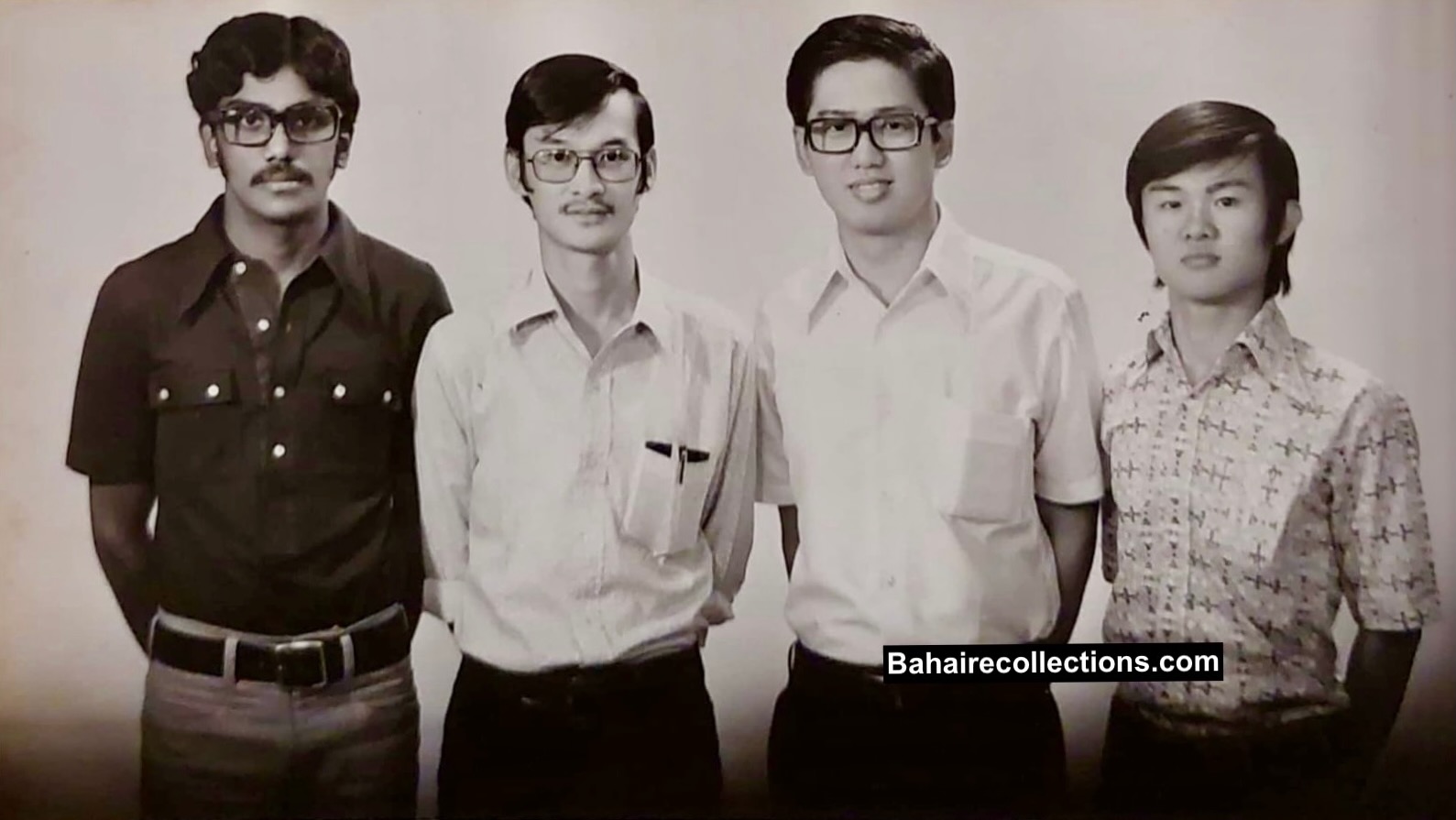
The Editorial Board of the Northern Star for 1973. L-R: Elangovan Govindasamy, Teh Teik Hoe, Boo Haw and Peter Chew Huat Chin.
The Northern Star had created a tremendous impact by establishing close and direct connection between Malaysian Bahá’í community and their pioneers overseas. The ‘Northern Star’, was posted all over the country and to our pioneers all over the world, and received tremendous flow of appreciation from the readers, some of which were published under the letters to the editor section. Counsellor Mr. Yankee Leong, our first believer of Malaya wrote as follows, “My Dear Boo Haw, My warm loving greetings to all the dear Bahá’ís in the north. The pages are brim-full with good news of Bahá’í activities in every field, youth, teaching work, conferences etc… I pray fervently that the Northern Star will shine bright and diffuse the teaching of Bahá’u’lláh far and wide….. Your activities and dedicated service will surely inspire all who read the Northern Star and inspire all to follow your example.”
Auxiliary Board member Mr. Leong Tat Chee from Malacca town wrote, at a time when he was suffering from terminal illness, “Thanks for posting me the Northern Star which is so informative and interesting. What a tremendous step in the progress or our Cause. Herewith some stamps.” The sensational Northern Star had all the features to shine as a national news organ, but it was short lived with its last publication being Volume 5 released in March 1974.
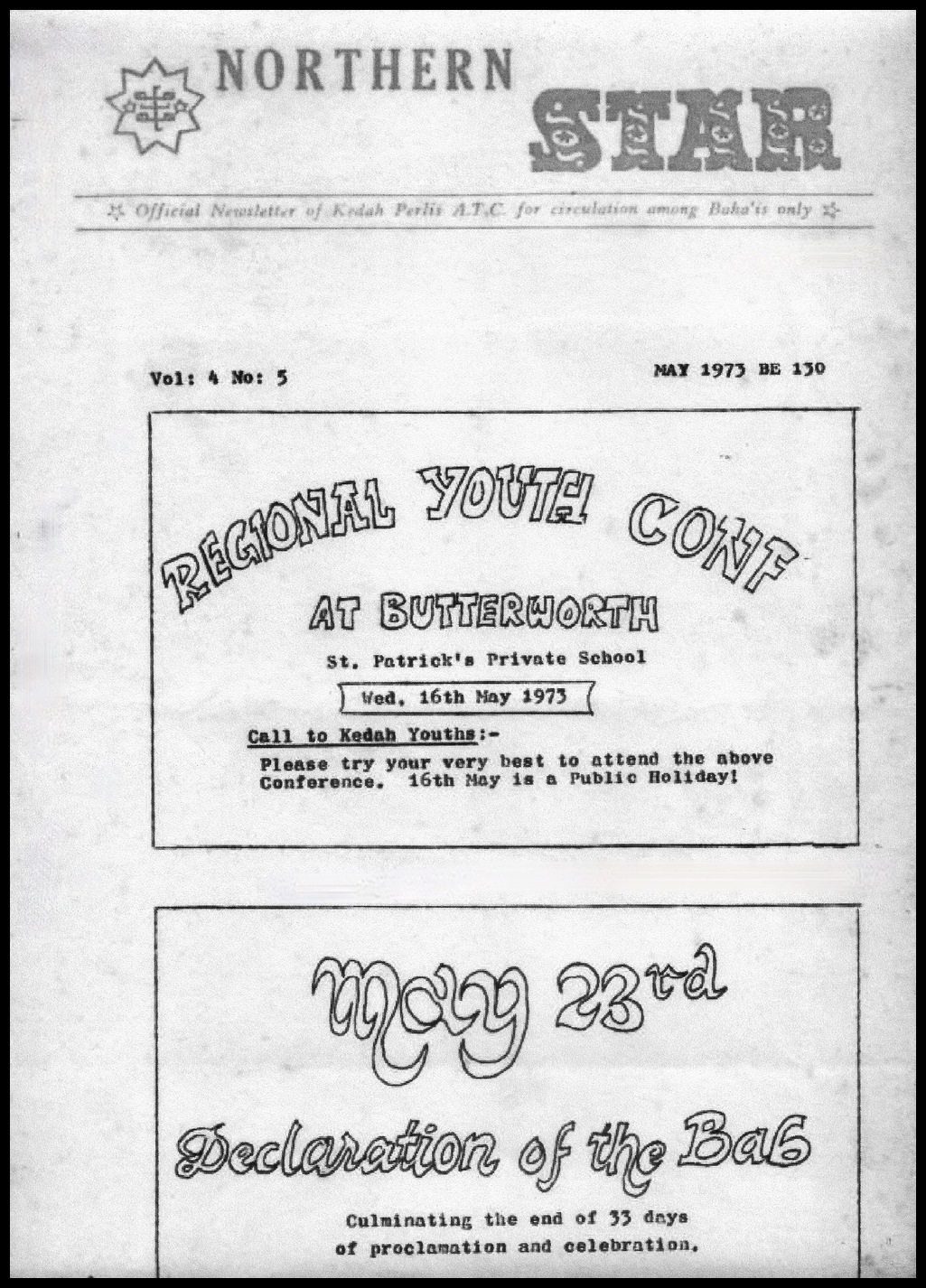
First page of the Northern Star with the artistic drawings of Boo Haw.
When the Northern Star ceased publications, there was still strong demand and so Chong Boo Haw and R. Kanthakumar produced some issues of a newsletter called “Gondwana” which means “One World.” This too was short lived.
SOME NATIONAL RESPONSIBILITIES
Boo Haw was given some vital tasks from the early days. With the launching of the Five-Year Period for Proclamation in (1967-1973) there was a need to set up some form of a Bahá’í Information Service. At the meeting of the National Spiritual Assembly held on 28 December 1969 the national institution decided to set up the National Bahá’í Information Service in order to spear head the proclamation activities in the country. When the State Information Offices were set up, Boo Haw was appointed representative for Kedah and Perlis. His duty was to compile statistics, maintain Bahá’í albums and audio-visual aids and pass on to the National Bahá’í Information Service.
In 1973 the National Spiritual Assembly appointed the “Malaysian Bahá’ís Overseas Committee” made up of Shantha Sundram, Chong Boo Haw and Teh Teik Hoe. The task of this committee was to write constantly to pioneers who were abroad and keep their spirit high. Those pioneers were sent the Northern Star so long as the issues were published.
EXTERNAL AFFAIRS WORK
Boo Haw was inclined to bring the Faith to the upper echelon in society, starting with his school days. Boo Haw was classmate of the current Sultan of Kedah since both of them studied at the Sultan Abdul Hamid College in Alor Star. Boo Haw was also a close friend of the previous Sultan who also served as the Fifth and Fourteenth King of Malaysia (Yang di-Pertuan Agong) and his spouse Sultanah Hajah Bahiyah binti Almarhum Tuanku Abdul Rahman. His good and radiant nature enabled him to cultivate many friends from all walks of life – from high-ranking Government officers down to the last man on the road.
MOST MEMORABLE DAYS
Following the opening of the Bahá’í House of Worship in New Delhi in 1986, Amatu’l-Bahá Rúhíyyih Khánum met the Bahá’ís of Malaysia in South Thailand in January 1987. Through prior arrangements, Chong Boo Haw was Amatu’l-Bahá’s designated driver, and he drove Amatu’l-Bahá and Mrs. Nakhjavani throughout their stay in Hat Yai. Amatu’l-Bahá Rúhíyyih Khánum also had a private meeting with the family of Boo Haw. During these days Boo Haw had learnt many lessons from Amatu’l-Bahá Rúhíyyih Khánum. Amatu’l-Bahá Rúhíyyih Khánum also visited the Tawa Island in this trip, along with Chong Boo Haw, Liu Man San, Leong Foo Cheong and Teh Teik Hoe. She also visited the Hat Yai Bahá’í Centre. Of the days spent with Amatu’l-Bahá Rúhíyyih Khánum, Boo Haw had remarked, “I felt most honoured and privileged to be in her presence. Those were the greatest days for me”.
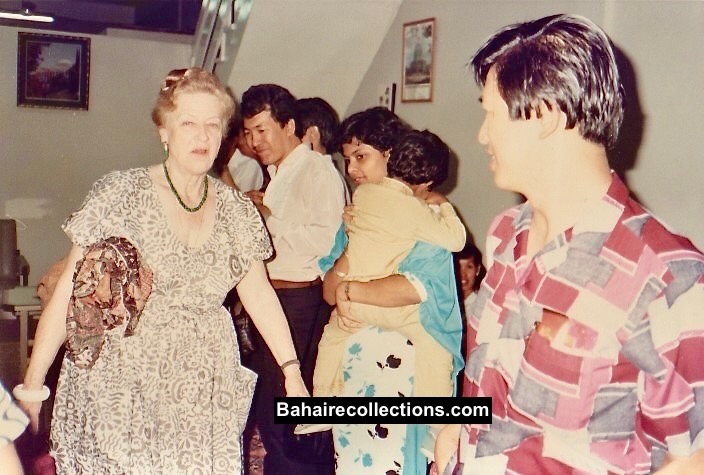
Amatu’l-Bahá at left and Boo Haw at right at the Bahá’í Centre of Hat Yai, Thailand in January 1987. Behind Amatu’l-Bahá is Liu Man San. Carrying a child is Malani Achro.
INDIVIDUAL INITIATIVES
Although Boo Haw served on the Local Spiritual Assembly of Alor Star and on some committees with dedication, time has shown that he was also a lone worker for the needs of the Cause. As a person of tremendous capacity and strong driving force he was capable of organizing single handedly what it would take a few men to execute a project.
There have been many moments and instances where he had initiated several projects for the Cause, and it is no surprising that Boo Haw himself did not record or remember many of them, all because he did not do them for self-fame or name.
We have seen how Chong Boo Haw chartered a bus from Alor Star on behalf of the Area Teaching Committee of Kedah and Perlis at the cost of RM38 per head. Likewise for the first Winter School of Malaysia held in Johor Bahru in December 1972, Boo Haw chartered an aircon bus for RM250 per day for 40 persons. It cost RM25 per person for the four days. His whole idea was to arrange the cheapest and yet affordable form of transportation to ensure maximum participation including those who had little means.
One of the notable occasions was the organising of the Fiftieth Anniversary of the Faith in Alor Star. Boo Haw received the blessings of the Local Spiritual Assembly of Alor Star to go ahead and take the lead in organising the event. Almost single handedly and single mindedly Boo Haw communicated with all the early believers of Alor Star to get the wheels turning. He produced a high-quality magazine containing photographs of early activities and got the author to write the History of Fifty Years of the Faith in Alor Star. Boo Haw himself funded the production of these two publications. And he also organised and trained a choir to present songs. This great event was finally held at the Sentosa Hotel on 28 August 2010.
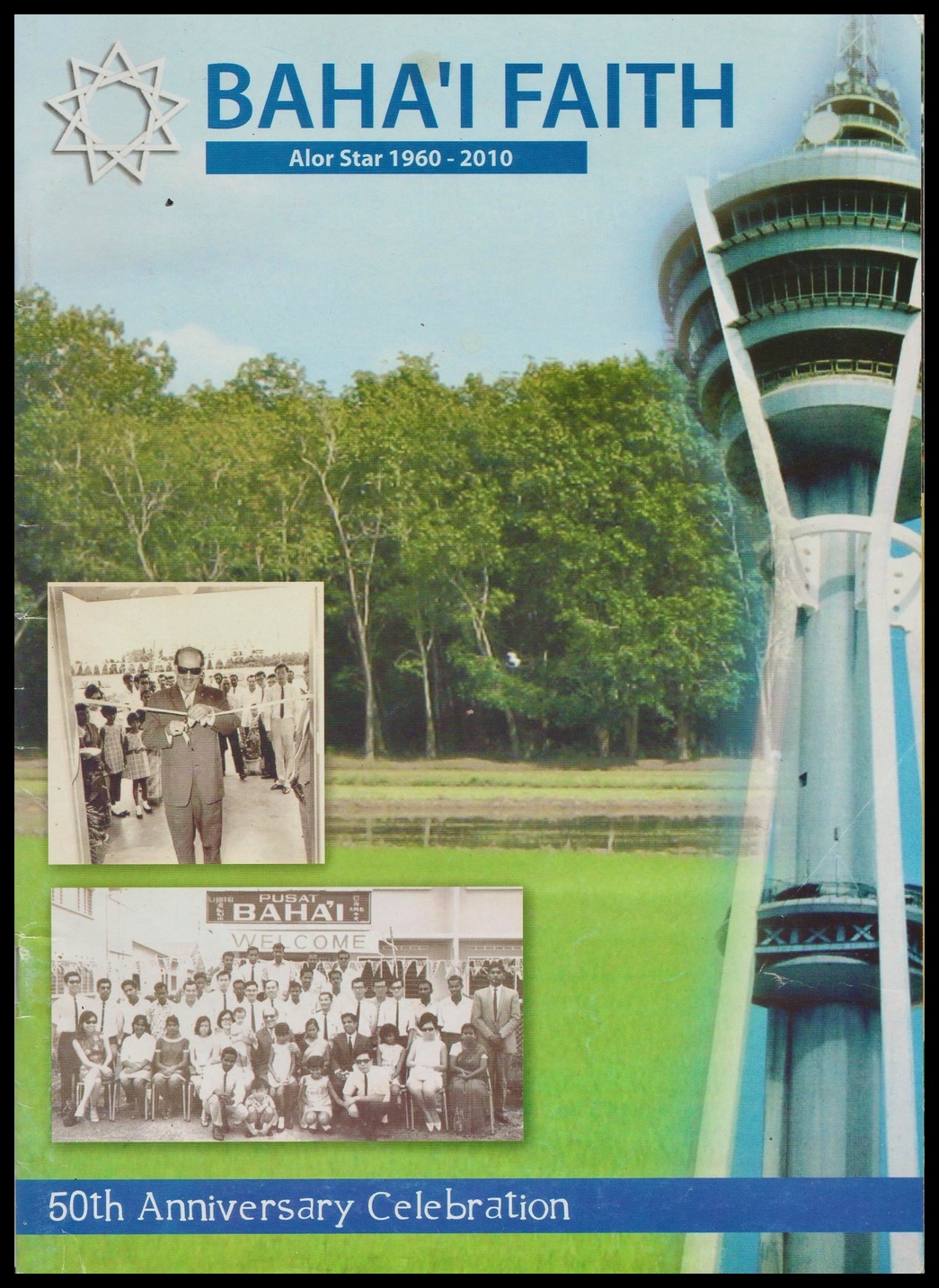 Magazine issued in celebration of the Fiftieth Anniversary of the Faith in Alor Star.
Magazine issued in celebration of the Fiftieth Anniversary of the Faith in Alor Star.

History of the Bahá’í Faith in Alor Star, that went for another reprint.
Boo Haw achieved yet another milestone in his life of service for the Faith – designing commemorative postal stamps and envelopes to mark the Bi-Centenary celebrations of the Birth of the Twin Manifestations in 2017.
He and Mr. T. K. Lee (Lee Tiew Kang) of Subang Jaya community teamed up to undertake this first-time effort. Boo Haw operated from Alor Star getting the design and envelope done while T. K. Lee who was able to realise the project without much hitch.
This has never been done before, as anything that has a whiff of religious connotation, the Malaysian Postal Office being the authorized producer of stamps for Malaysia, would not sanction. Fortunately, through a friendly relationship that T.K. Lee developed with a senior officer at the Stamp Office, these two managed to place an order of one thousand sheets of stamps. Priced at 60 cents each they came in 20 stamps per leaf which were successfully procured from the Postal Office. In addition to the stamps, they also designed and produced envelopes to go with the stamps.

Commemorative postal stamp on an envelope to mark the Bi-Centenary celebrations of the Birth of the Twin Manifestations in 2017.

Postal stamp to mark the Bi-Centenary celebrations of the Birth of the Twin Manifestations in 2017.
To produce First Day cover, the stamp and the envelope must have the birth date of Bahá’u’lláh to be stamped. To our dismay, it just so happened that His birthday fell on the sunset of 21 October (Saturday) to sunset of 22 October (Sunday). The postal office in Kuala Lumpur was obviously closed on weekends.
Undaunted, Boo Haw organized to have the envelopes stamped in the Alor Star postal office as in the State of Kedah, Sunday was a working day. The manager of the post office in Alor Star was kind enough to allow the Bahá’ís to use the Post Office date stamp to chop the date on one thousand envelopes. It was a day long affair involving a team of youths.
The Bahá’í Bookshop was commissioned to sell and orders came pouring and in no time, a thousand envelopes as first day cover were snapped up and so were the one thousand leaves of stamp. This unprecedented incident brought great publicity for the Cause.
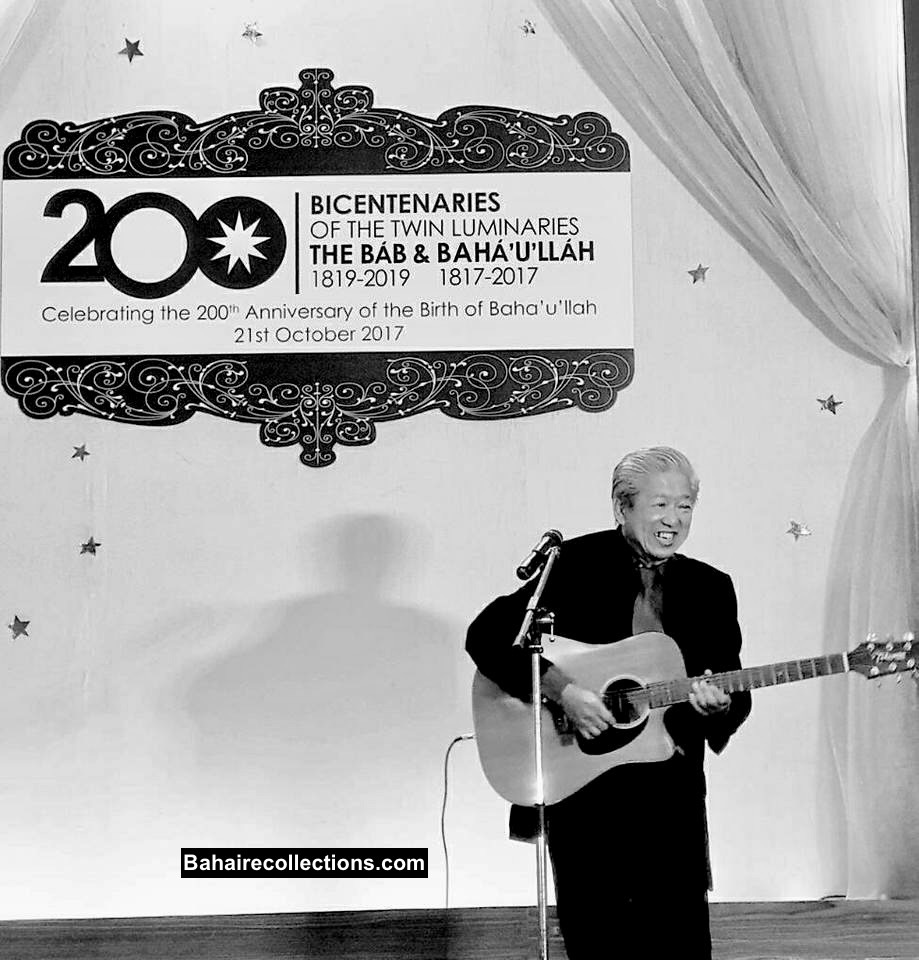
Electrifying presentation at the Bi-Centenary Celebrations of the Birth of the Twin Manifestations in 2017.
Many of the services by Boo Haw were carried out quietly, and behind the scenes without fanfare. One area was printing of Bahá’í books in English and other languages for communities abroad. Boo Haw assisted in providing Timor Leste community with two sets of books—one in black and white, and one in colour. They deeply appreciated his love and support. Owing to the generosity of Boo Haw they had enough books for the last 10 years, and only recently printed more prayer books. He had also published Bahá’í prayer books for the Myanmar Bahá’í Community. For South Sudan too he printed Bahá’í prayers books in three languages- Arabic, Acoli language and English. He printed the prayer books in Iban, English and Malay languages for the Sandakan community in the state of Sabah when they organised their 50th Anniversary celebrations in 2012. He also printed books for the children for Sabah which are being used till this day. He communicated by email with the receiving countries for proof reading and corrections. When all proof-reading and corrections were done all those books were all printed in Alor Star at Boo Haw’s own expenses. The books came out flawless and in good quality. The receiving countries expressed their most profound gratitude to this kind gesture.
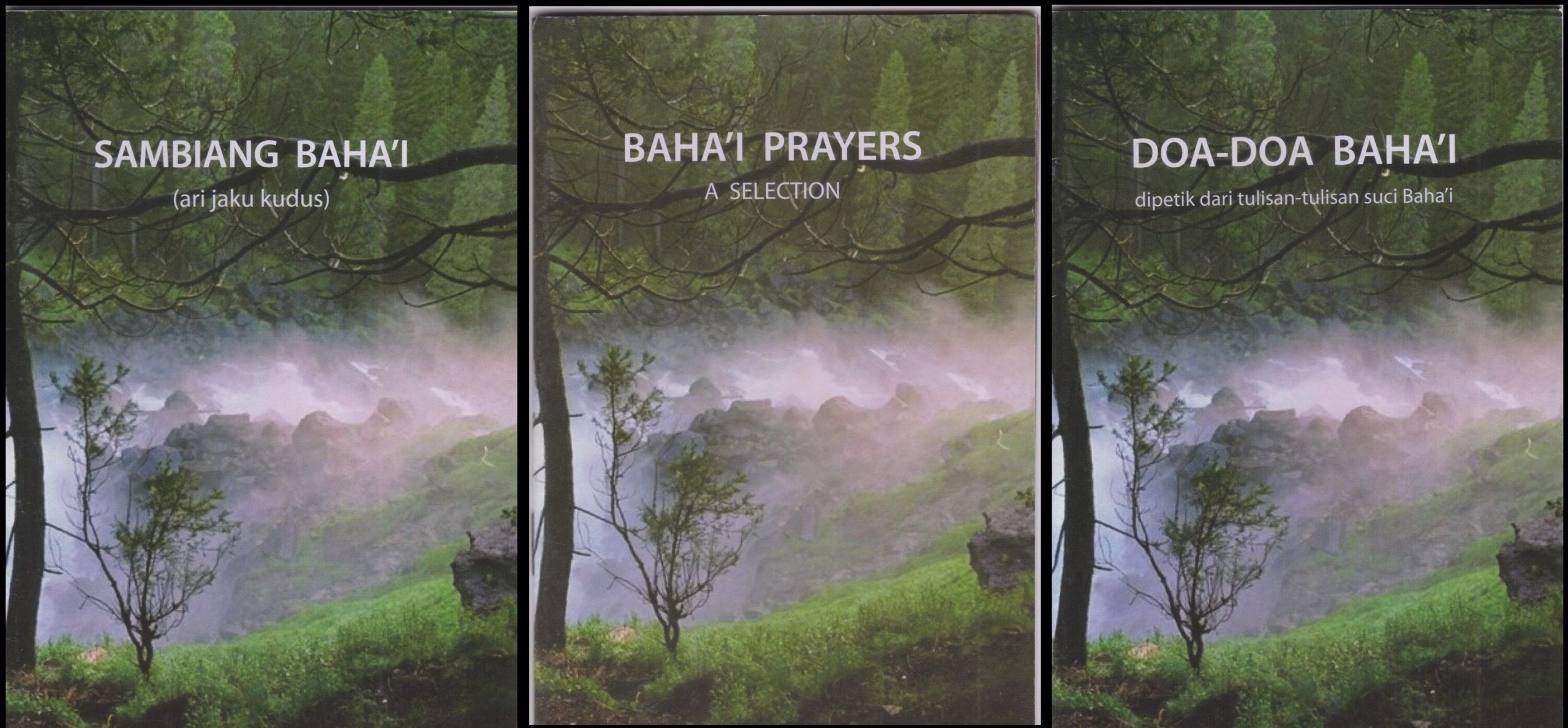
Prayer books for the Sandakan community. L-R: Iban language, English language and Malay language.
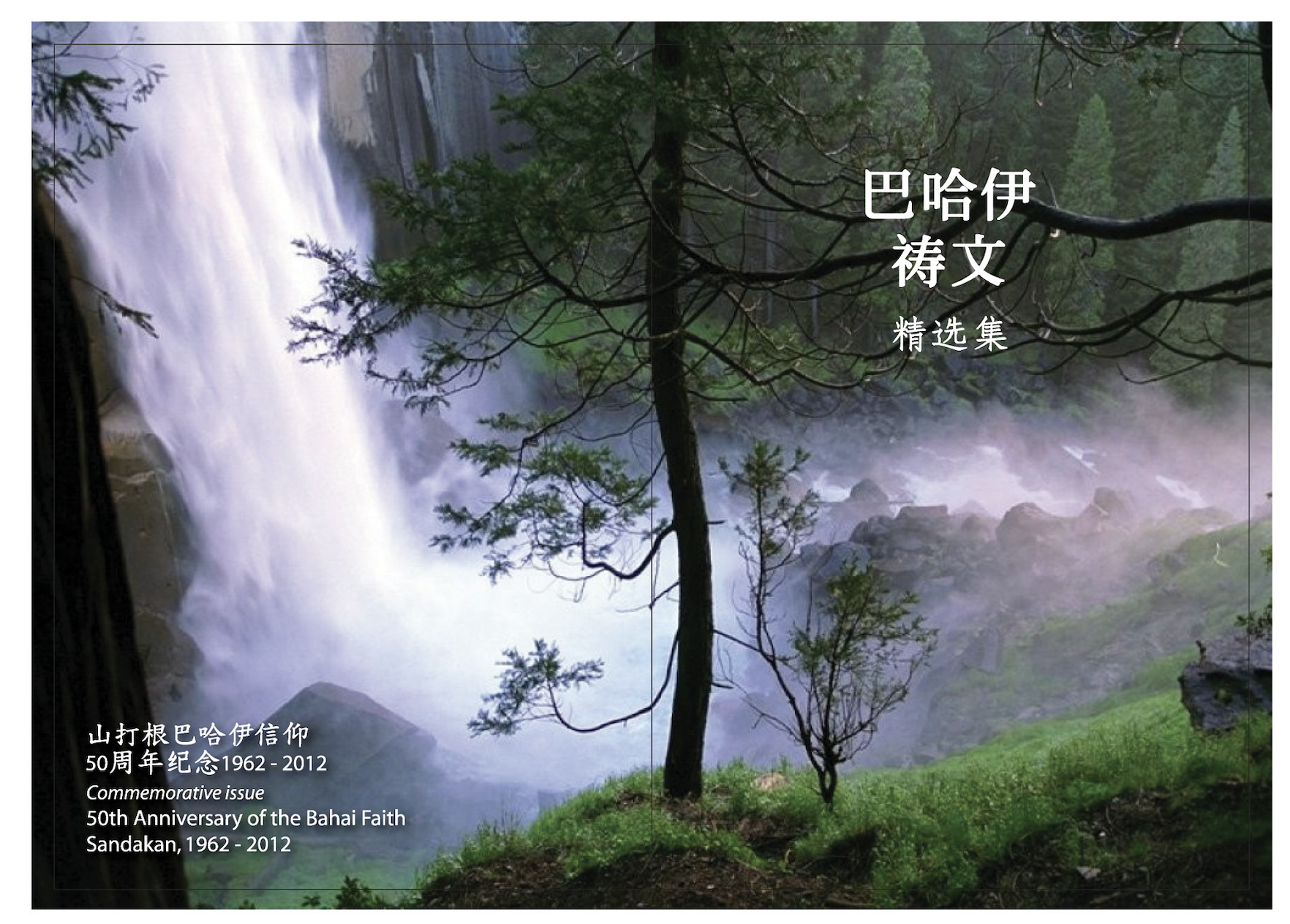
Front and back covers of the prayer book in Chinese for the believers in Sandakan.
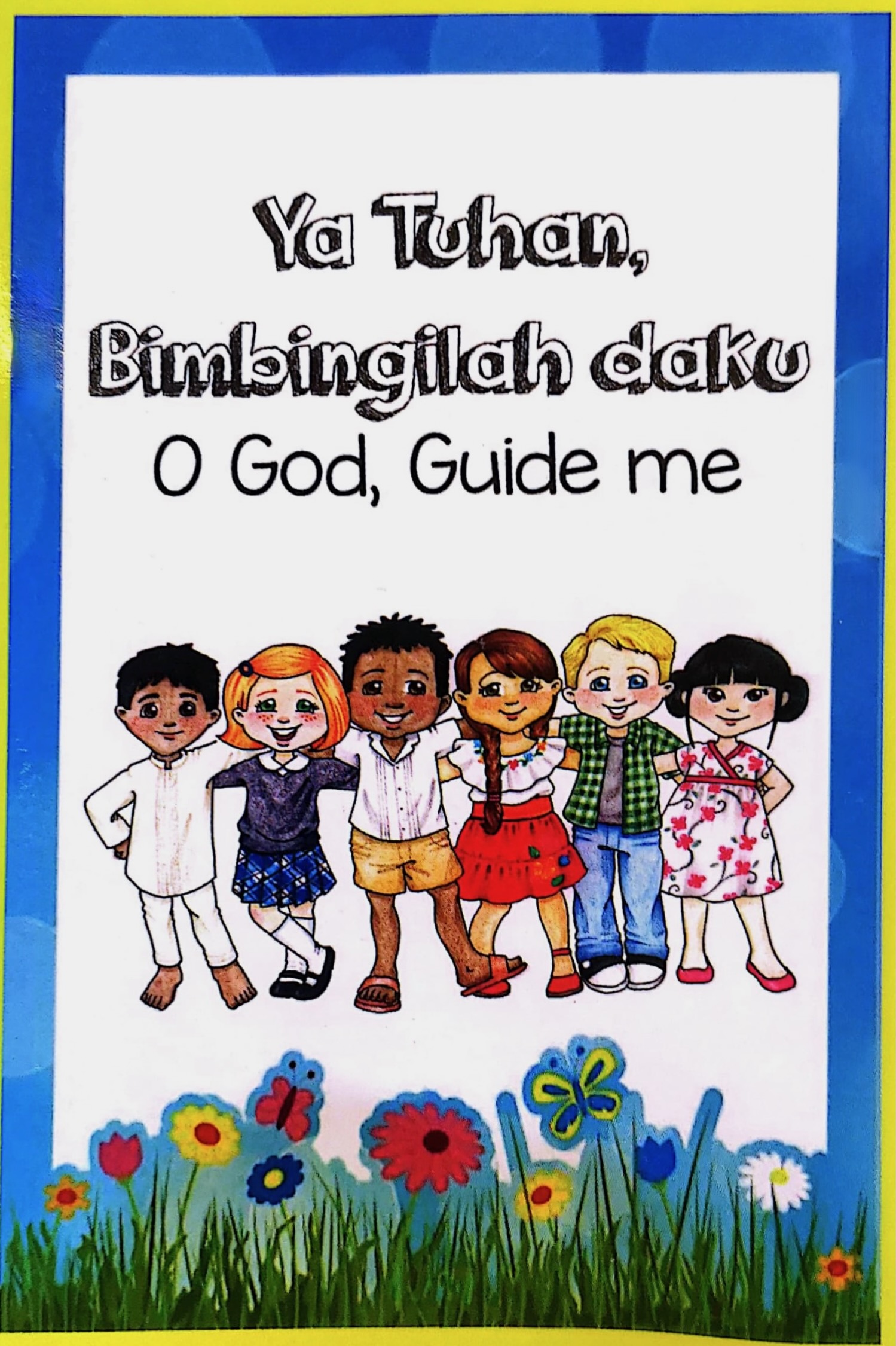
Book for the Bahá’í children for Sabah.
 Front and back covers of the prayer book for the Myanmar believers.
Front and back covers of the prayer book for the Myanmar believers.

Prayer book for the South Sudan believers.
 Front and back cover of the prayer book for the Timor Leste believers.
Front and back cover of the prayer book for the Timor Leste believers.

Children’s prayer book for Laos.

Prayer book for Cambodia
There were several other books and booklets that he had published. On many occasions communities within and without Malaysia had requested Boo Haw to design and print books, which he gladyy obliged. But when they came forward to make the payments, he respectfully declined, saying it was his contribution for the Blessed Faith.
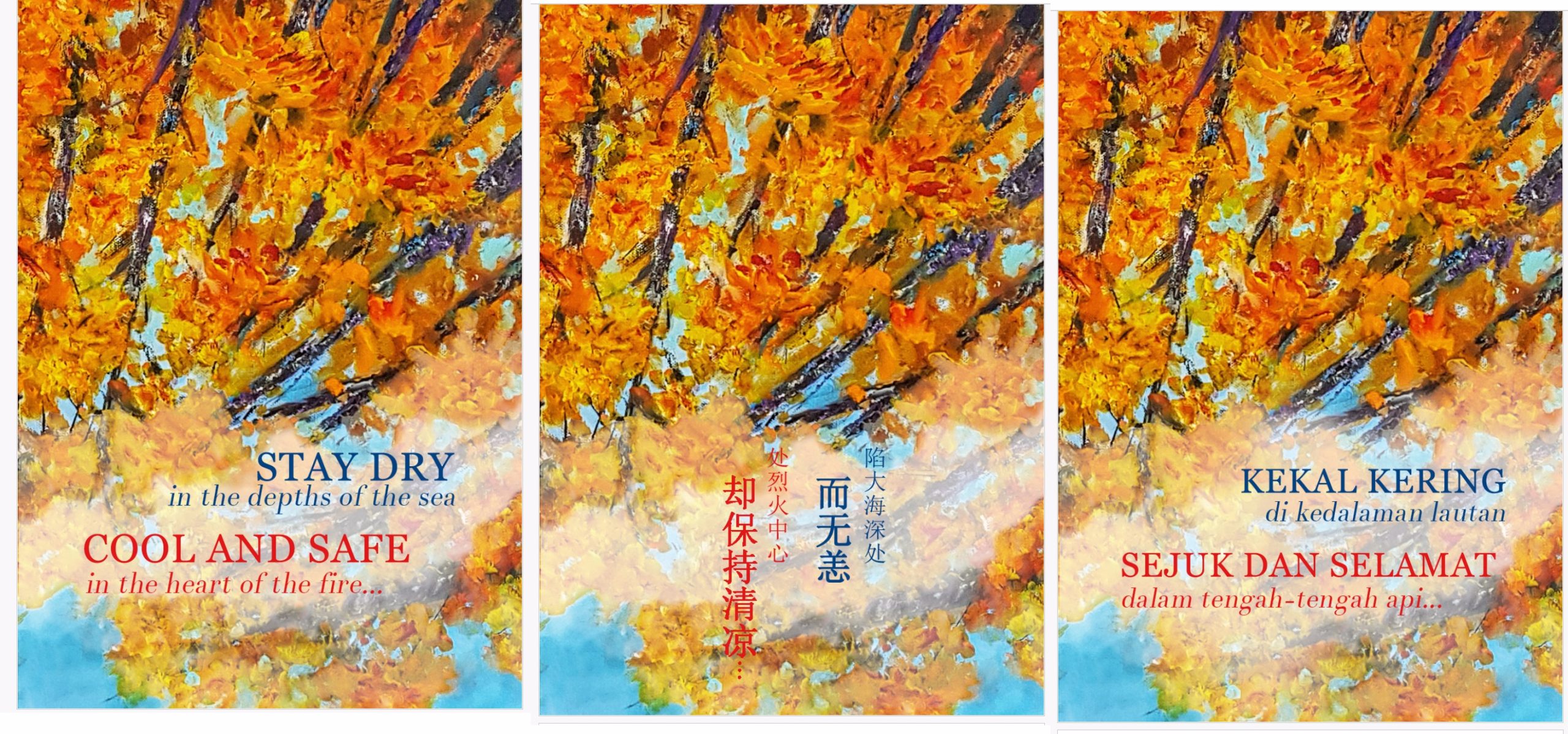
“Stay Dry in the depths of the sea” in English, Chinese and Malay. This is a compilation extracts from the Writings of Bahaullah, Abdul Baha, Shoghi Effendi and letters from the Universal House of Justice that were printed in 2020.
One of the last projects was the long-awaited book called “Tell Me A Story” published in 2022, consisting of 46 short stories from his friends. He came out with English and Chinese versions and dedicated the books to Yankee Leong, Leong Tat Chee, Nagaratnam, Choo Yoke Boon and many others who had been his mentors and inspiration. It was not an easy task as it took him three years to encourage, cajole and at time push the friends to share their short stories. His continual autographing of the book for the many visitors who visited him in the later part of his life was his moment of joy. He was hoping that more friends after reading the book will come forward to contribute their stories for publication in the next sequel , but he succumbed to illness.
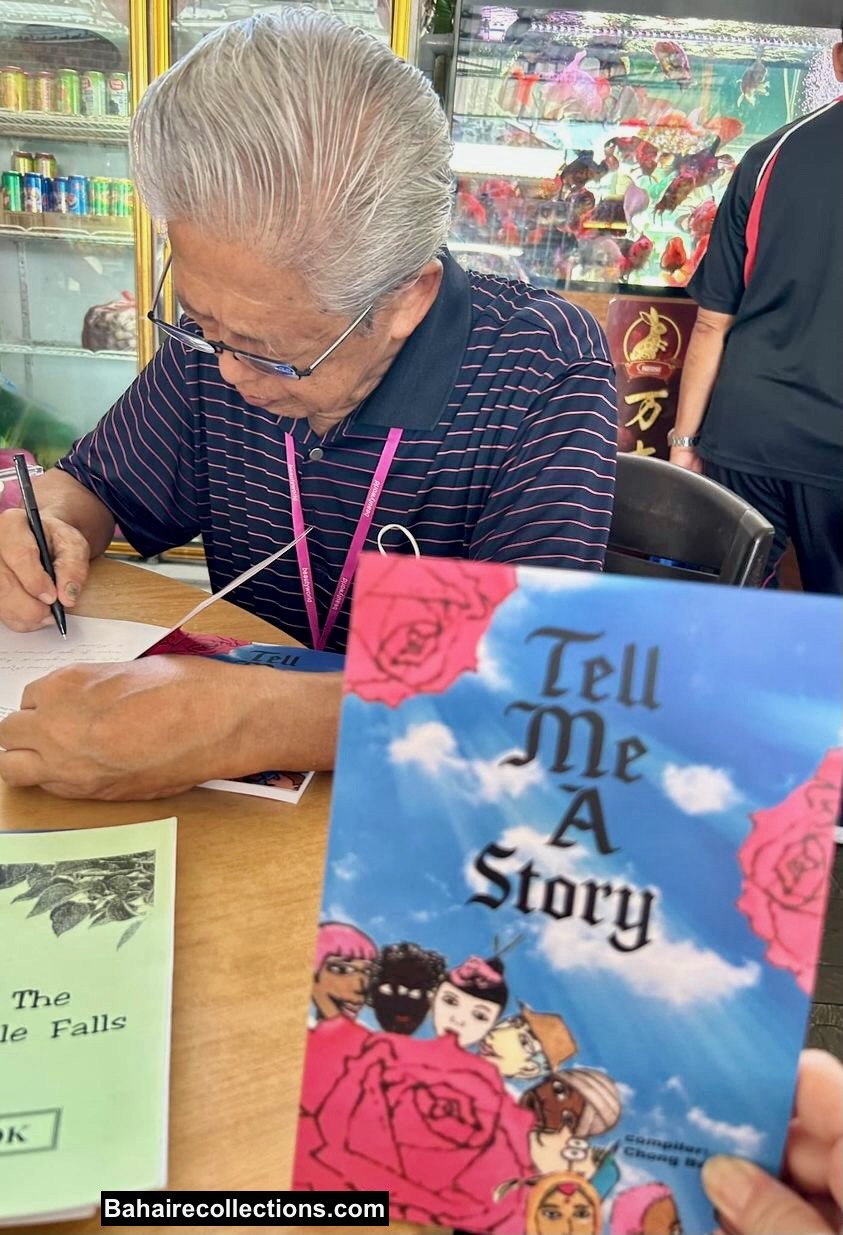
Boo Haw autographs the book “Tell Me A Story”.
Boo Haw owed a debt of gratitude to Mr. Loo Yew Fook, Manager of the printing press in Alor Star who gave assistance in every way in getting these books out at reasonable cost and in high quality.
LAST DAYS
In about 2016 Boo Haw had bought an apartment in Petaling Jaya in the same neighbourhood as his son and daughter. He used to alternate between his home in Alor Start and to the apartment in Kuala Lumpur. He last served on the Local Spiritual Assembly of Alor Star for the period April 2018 to 2019. With that he became the longest serving member of the Local Spiritual Assembly of Alor Star –half a century.

Clearing of the Bahá’í Burial Ground on 14 Febraury 2021. L-R: Ang Fong Hwa, Chan Guan Heng, Ulaganathan and Boo Haw.
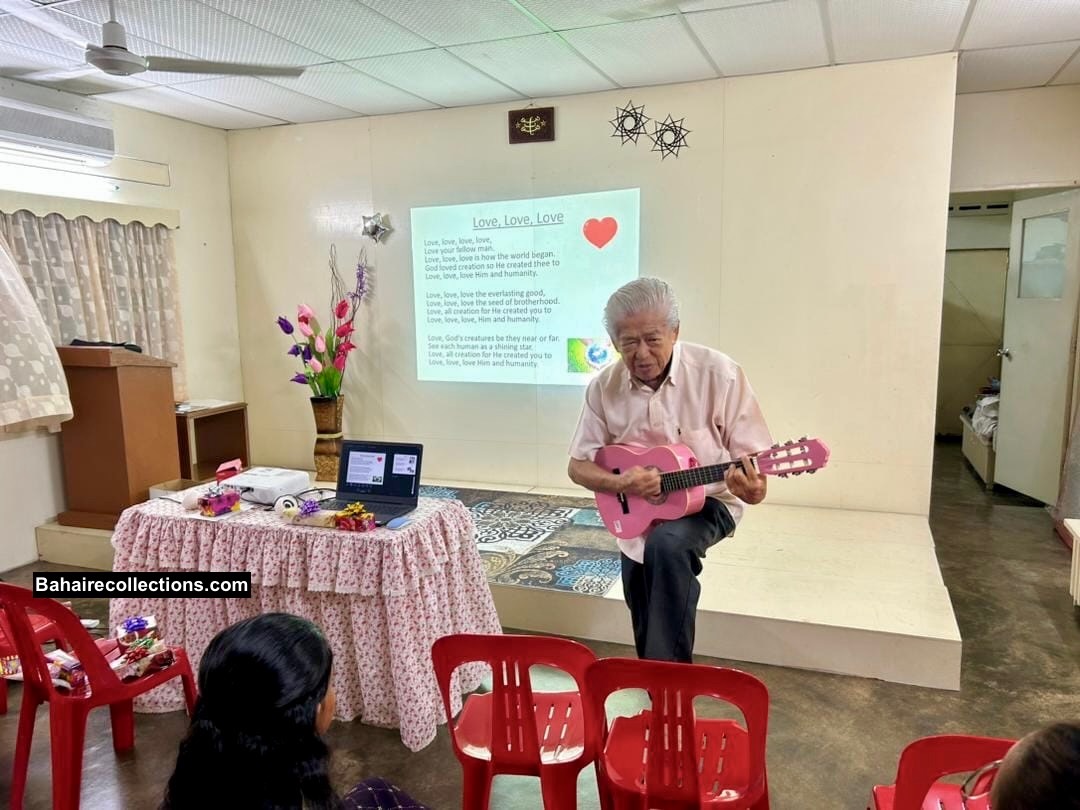
Boo Haw sings at the Ayyam-i-Há celebrations at Alor Star Bahá’í Centre on 28 Feb 2023- one of his last presentations in Alor Star.
Undertaking teaching trips or visiting communities was always part of Boo Haw’s passion. On 28 July 2013, Tan Boon Tin of Ipoh, who was well connected and very familiar with the Asli believers in Perak brought Boo Haw and some friends to visit the Asli Bahá’ís at Kampong Chang, Perak, to enable them to witness for themselves the development of the community there. The visitors were very impressed by the hospitality given by the Asli friends.

Bahá’í Centre at Kampong Chang, Perak on 28 July 2013. Seen here from L-R: David Soo, Mrs. Ong, Mr. Ong Lean Eng, Master Kuan Ting, Jacky, Cheng Jooi Sey, Goh Kean Kooi and Boo Haw. Seated is Leong Seng Tong.
By 2023 he was already walking with a cane, owing to ill health. Dr. Firaydun Mithaq passed through Alor Star on way to Padang Lembu Estate in the south of Alor Star. Boo Haw insisted in following him to Padang Lembu Estate to be with the simple folks.
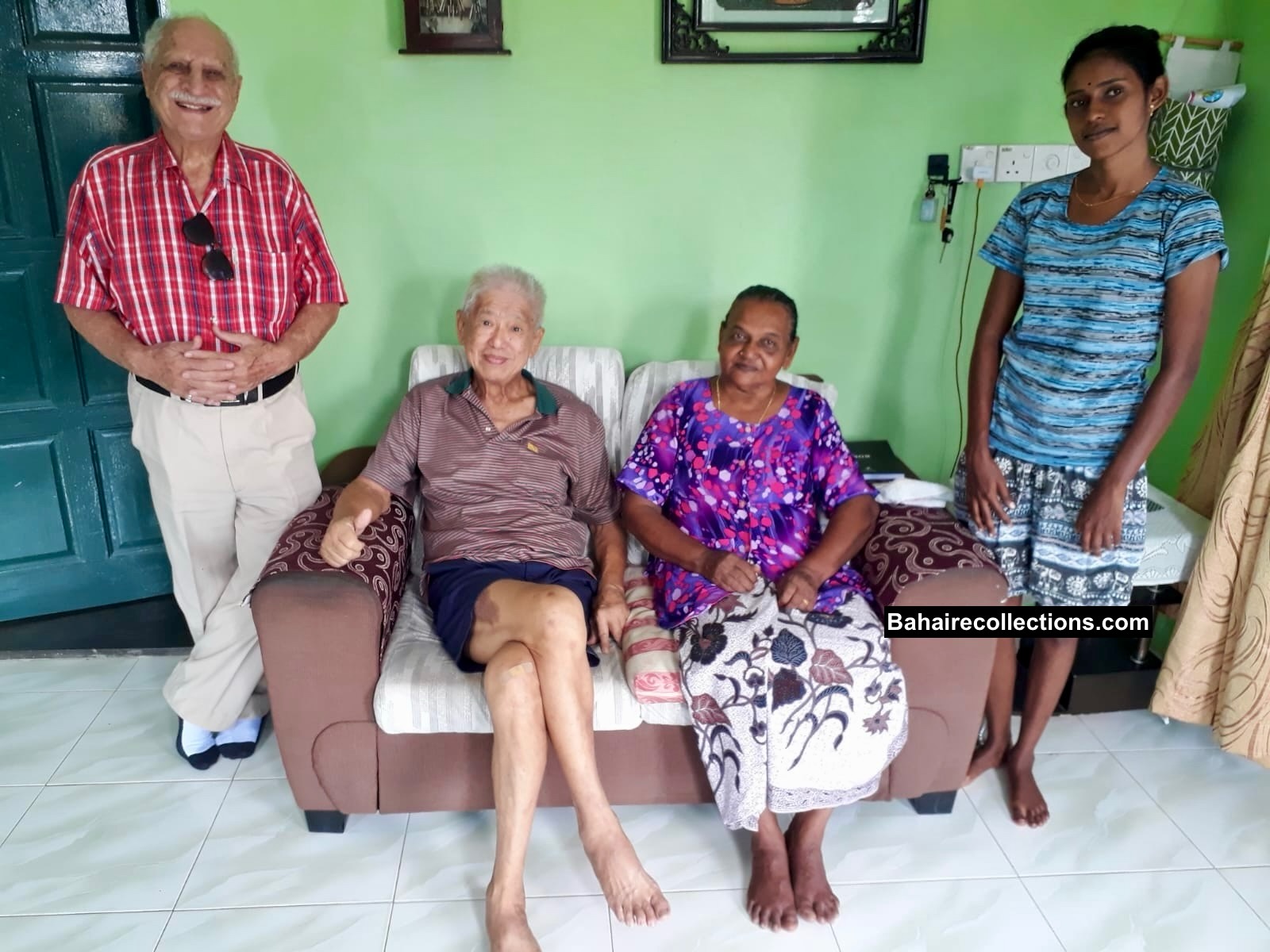 Visit to the Padang Lembu Estate in 2023. Seated to the left is Boo Haw, who by this time was walking with a walking stick. Standing at left is Dr. Firaydun Mitha from Chiang Mai, Thailand.
Visit to the Padang Lembu Estate in 2023. Seated to the left is Boo Haw, who by this time was walking with a walking stick. Standing at left is Dr. Firaydun Mitha from Chiang Mai, Thailand.
Until August 2023 Boo Haw and his wife Siew Gaik were alternating between Alor Star and Petaling Jaya. During these visits they will plan and invite small group of Bahá’ís from their era to gather for meals, prayers and some deepening sessions. There will be singing as well. This was a regular activity that got so many of the early Bahá’ís to meet and have some reunion. Here too visiting believers from abroad were hosted.
PASSING
In September 2023 the family moved into Kuala Lumpur for good owing to Boo Haw’s failing health. With that, Boo Haw became the last of the veterans of Alor Star to have left the community after serving on the Local Spiritual Assembly there for close to 60 years. His transfer to Kuala Lumpur facilitated his children to take them for proper medical check-up and care.
Sadly, in the same month of September Boo Haw was diagnosed with cancer of the stomach. Any normal person would have been shattered. But he was the same ever vibrant Boo Haw and continued going on with life. He resorted to saying a lot of prayers and reading the Holy Writings. Yet, as always he loved to recollect stories of past events in the country. Whenever visitors came the topic of discussion was always on old stories. It was just timely that he got hold of the book, “Diffusers of Divine Fragrances- An Account of the Visits by Hands of the Cause to Malaysia” by the author. Boo Haw who had so much respect and reverence for the Hands of the Cause was immersed in going through the book and laughing at the paragraphs where he was mentioned, and of which he had forgotten. That was the last major book he read.

Boo Haw enjoying the book “Diffusers of Divine Fragrances – An account of the visits by Hands of the Cause to Malaysia“
The deadly cancer was still a concern for the family. The consolation was that owing to dementia which had set a few months earlier Boo Haw was not able to understand if he had that disease, and most of the time did not complain of any pain. There used to be regular visits paid by his friends and the atmosphere was very electrifying with songs, jokes and laughter. And whenever musically inclined believers visited Boo Haw, he would request them to sing for him. When Jimmy Seow of Australia visited Boo Haw in March 2024, Boo Haw requested Jimmy to sing the song “Hope” that Jimmy had composed. Surprisingly friends came to cheer him, but on many occasions it turned out with Boo Haw cheering them with his songs, guitar and jokes. He was physically weak, but when he was alert he was keenly alert.
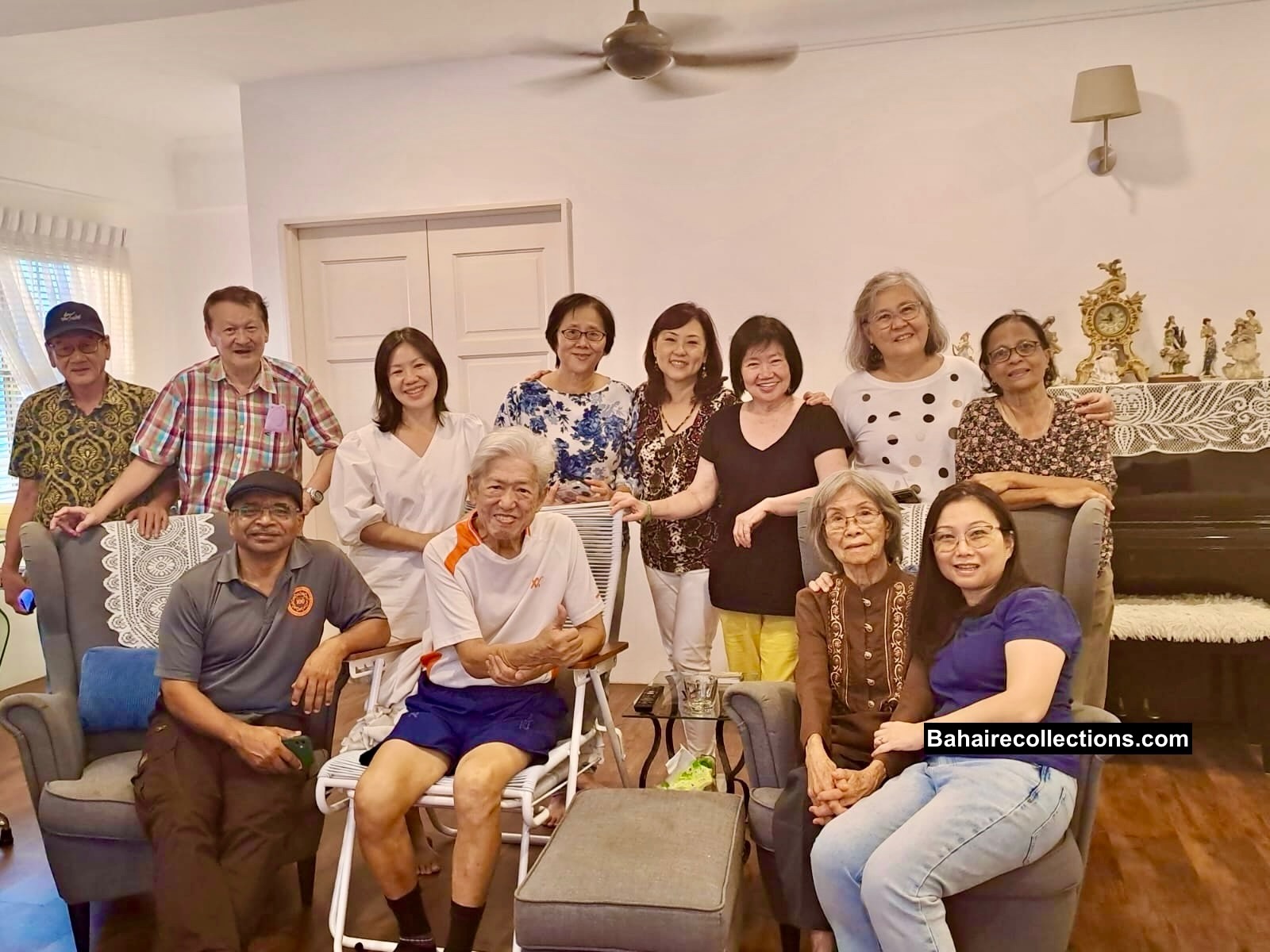
Old friends from the Alor Star community visiting Boo Haw on 4 December 2023. Seated L-R: R. Kanthakumar, Boo Haw, Mrs. Phung Woon Khing and Phung Li Chen. Standing L-R: Tan Boon Tin, Teh Teik Hoe, Sharmaine Chong, Kim Siew Chin, Judy Phung, Siew Gaik, Boon Kun Tan, Odette Kanthakumar. (Photo Courtesy: Phung Li Chen)
Despite his ailment, Boo Haw surprised the visitors by his highly energetic performance. Seated to the left is Judy Phung (Video Courtesy: Phung Li Chen)
It was again in the same month of September that Boo Haw was chanting the Firmness in the Covenant prayer to which his son Zohrab played the piano. The last song which Boo Haw sang and Zohrab recorded on his handphone was the “Thank You, Thank You” song, with Boo Haw providing the words and music. He still had a sharp mind and energetic disposition. In stages his dementia surfaced its ugly head from time to time.
The last song by Boo Haw.
News of his ailment spread, and his old friends started to visit him to cheer him up. It turned out to be the other way. It was Boo Haw who started to cheer them with his songs and strumming of guitar, so much so the visitors simply could not believe what they witnessed. Boo Haw fell down at home and was rushed to the hospital. On 18 July he passed away in hospital, plunging all who had known him into great sorrow.
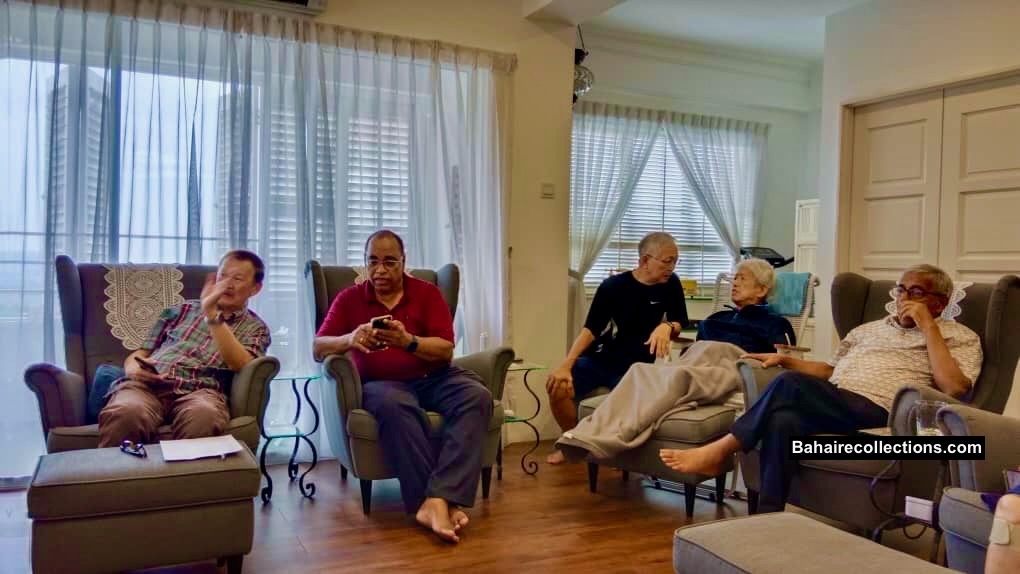
Visit paid by friends on 9 July 2024 – just a week before Boo Haw was admitted to the hospital. L-R: Teh Teik Hoe, Sathia Narayan, T. K. Lee, Boo Haw and N. S. S. Silan.
A befitting funeral service was held in his honour. During the service, the family played three tracks from the unreleased album ‘The Ladder,’ allowing those present to hear Boo Haw’s voice one last time. He entered the Faith with music, and with music, he was sent off.
It was with this song – “The Ladder” with which Boo Haw was sent off.
LEGACY OF A LEGEND
There was a charm about Boo Haw, seldom seen in others. There was always a radiance on his face, with a smile that was heavenly. When met by any visitor, or when meeting a friend for the first time, Boo Haw always had a joke followed by a loud laughter. Boo Haw was always jovial, spreading joy wherever he went. At summer and winter schools, a few very close friends would often whisk him away to a coffee corner after sessions for uproarious laughter and positive vibes. His love for laughter was infectious, bringing joy to every gathering he attended. His words, jokes and conversations- his very company invariably enhanced one’s spirit. He gave nicknames to his friends or group of friends. He formed WhatsApp groups for sharing jokes and laughter. Whenever he was asked why he had been late in doing something his answer would be, “My name is Lambert since I am always late.” Lambert has been coined from the Malay word “lambat”, meaning late. When he is corrected on a matter he would say, “You is right.” He had his own sad moments, which he would not share with others. He believed in diffusing joy and laughter to others.
He is remembered as one with a jolly side as well as a very serious one. While Boo Haw joked and played jokes, he had his very serious part as well. Whenever the subject of discussion took a turn towards the Faith, he would end his jokes and take over a serious note in the conversation. He knew where to draw the line.
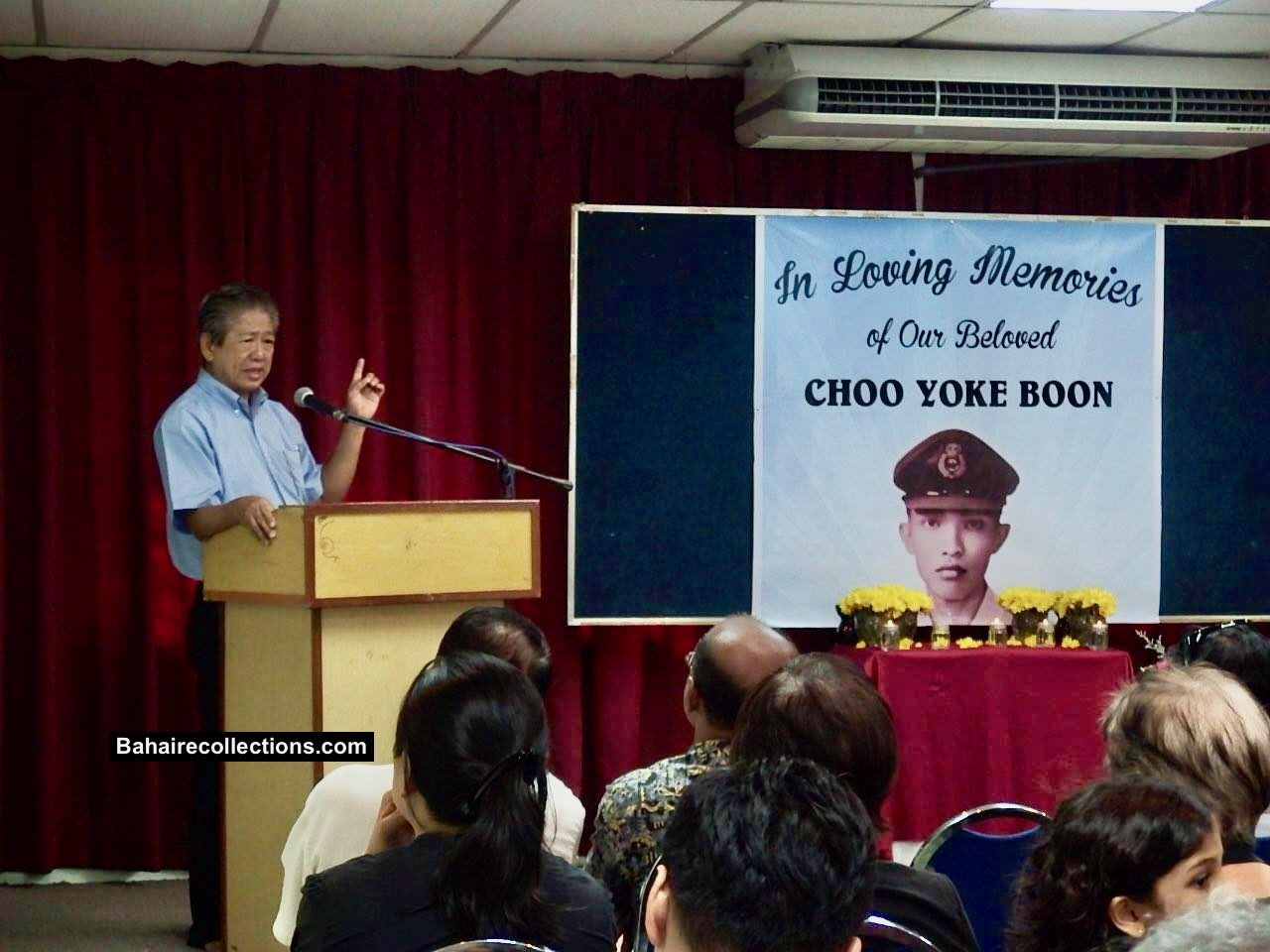
An emotional talk that Boo Haw delivered at the Sungai Petani Bahá’í Centre on 11 December 2015, on the occasion of exhuming the remains of Captain Choo Yeok Boon to be reburied at the Nirvana Memorial Park in that town.
He was well informed of the problems and prospects of the community across the country. He won the trust of both the elected and appointed institutions, to whom he did not fail to provide his undivided loyalty. He ensured that all tasks undertaken for the Cause were fully accomplished, with his heart flooding with an intense feeling of relief.
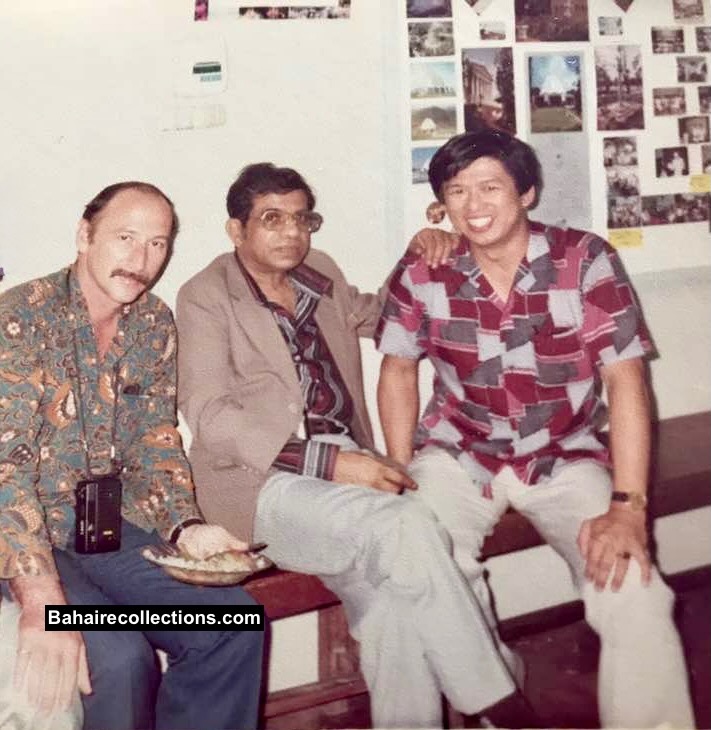
Hat Yai, Thailand in January 1987. L-R: Victor Greenspoon, Counselor Dr. Chellie J. Sundram, Boo Haw.
Throughout his Bahá’í life, there was seen a powerful driving impulse in that propelled him to do many things for the Cause that he loved and served. They were mostly as individual initiatives, carried out with meticulous planning. He had often remarked to his close friends, “I wished God had created 30 hours per day!” It was earning the good pleasure of the Blessed Beauty that became the goal in his life. Seldom he lost his temper or got angry. He had a rare talent in keeping his cool under all moments of stress, distress or strain. Boo Haw always had an even temper and a winning disposition, which attracted many to him.
Helping individuals quietly was part of his self, as the word “No” for any genuine request was never in his dictionary. There have been moments when he went out of the way or volunteered to drive visiting believers around or receive them from far off places. And taking visitors for posh restaurants for sumptuous meals was one activity that always pleased his heart. Boo Haw never failed to support any good efforts done for the Faith. He praised whenever something was done for the Faith and would even go a step further to suggest as to how things could be improved further.
Within the family Boo Haw had been a loving, supporting and empowering father to his children as well as to his grandchildren. He showered both material and non-material love without expecting anything in return. Laughter was what spurs him in the family. His constant advice to his son Zohrab Chong and daughter Shermaine Chong was “walk the spiritual path with practical feet”. Boo Haw most happy to witness within his lifetime his children serving the Faith most satisfactorily in various capacity. He was equally happy to have been blessed with the best wife, who was most supportive of all his Bahá’í activities.
It is only natural that Boo Haw’s son Zohrab inherited the musical talents of his father. Zohrab started off as a guitarist and a vocalist under the shadow of his father. In 1999 Zohrab produced an album called “The Ladder” based on original music composition containing a few prayers and the Hidden Words of Bahá’u’lláh. Boo Haw provided the lead vocals for this album.
Boo Haw had a rare talent, seldom to be seen in others. He was known to have an affinity for children. Children just get attracted to him. He would certainly have made a first-class children class teacher with his ability to also sing and draw. Whenever opportunity presented itself Boo Haw devoted time to train children in singing or developing other talents known to him, such as painting.
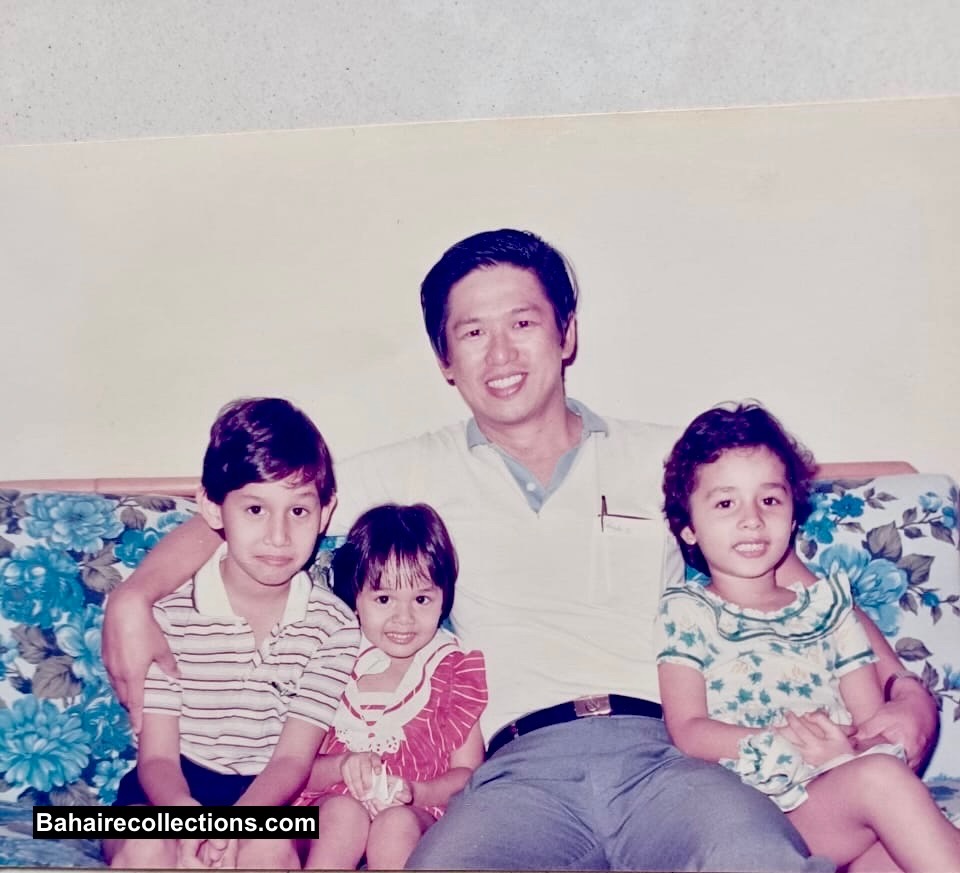
Boo Haw had a great love for children. Seen here with the children of T. K. Lee and Parvaneh of Subang Jaya. L-R: Naysan, Shabnam, Boo Haw and Naseem.
Basically, he was a very spiritually tuned believer, putting the Faith above everything else. Ignited by the love for the Cause, Boo Haw served without relaxing until his last earthy moment was spent. As a lighted lamp in the Cause, his love for the cause was always graven in his heart. That he served incessantly with a great zeal and ardour and with indomitable spirit from the day his soul was quickened by the Divine Revelation of Bahá’u’lláh is no secret. His unswerving loyalty and devotion to the Faith, his firmness in the Covenant and instant obedience to the institutions were demonstrated throughout his Bahá’í life.
Although Boo Haw had charted a unique path in music, he had achieved a great deal in other areas as well. Though well praised for his excellent performance in whatever he undertook, Boo Haw was clear that too much of praise can lead to the inflating of his ego which would ultimately and surely steal away his true self – humility. He possessed true humility equaled by few. He dressed simple to be with the common man and smartest when representing the Faith at important functions. Boo Haw was always consolation to the poor and an example to the rich, in every way possible.
Boo Haw’s spirit continues to live on not only through music, but also through the manifold areas of quality service he rendered the Cause. The hearts he touched deeply and filled along the way are far too many. We can be assured that this noble soul is in the company of the Concourse on High. Ours is the duty to beseech the Blessed Beauty to bestow infinite heavenly bounties upon this noble soul of Boo Haw who has earned a special place in our hearts. His is a story that shall provide timeless inspiration for the believers now and in the future.
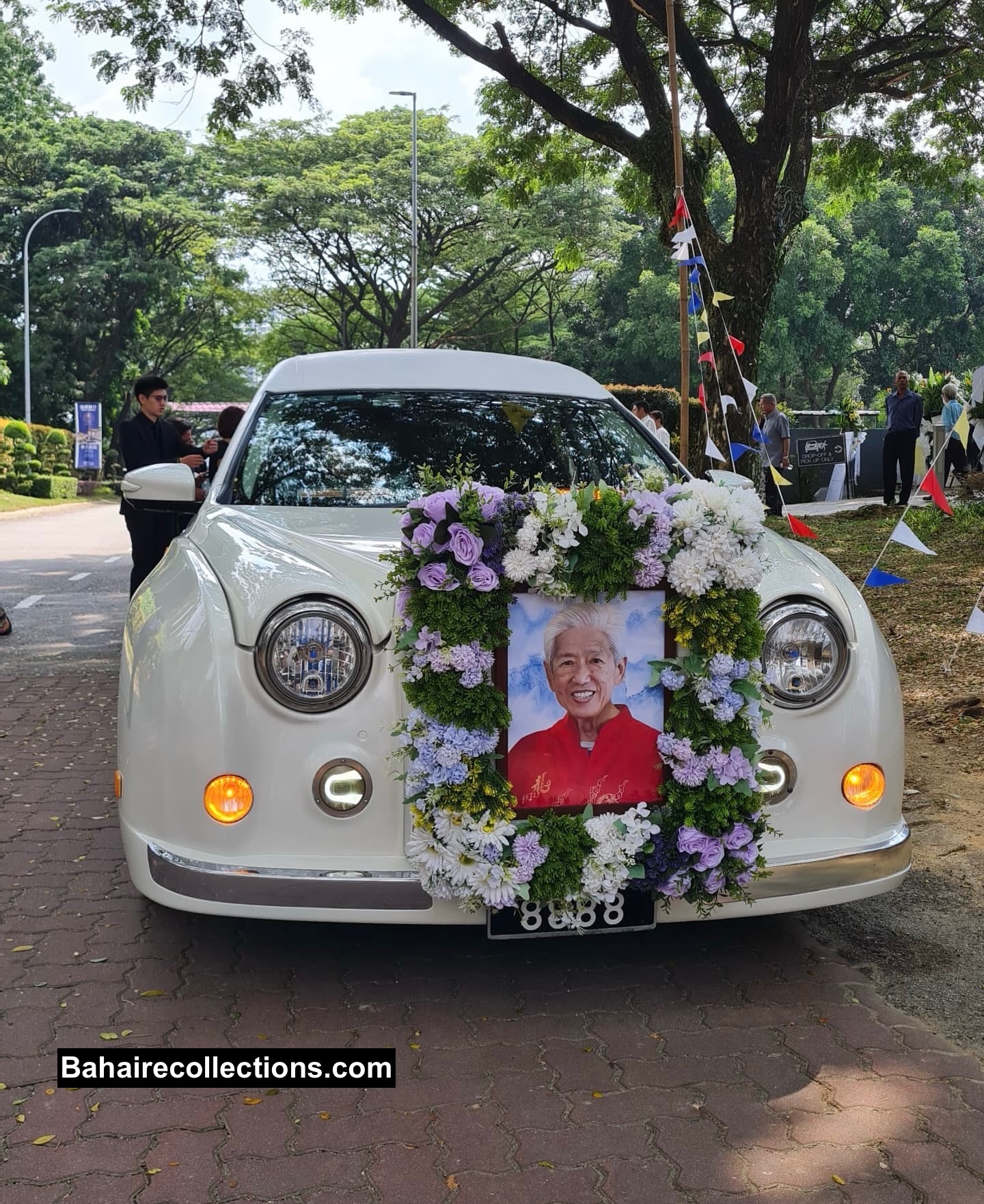
A kingly send off.
“Whither can a lover go but to the land of his beloved? and what seeker findeth rest away from his heart’s desire? To the true lover reunion is life, and separation is death. His breast is void of patience and his heart hath no peace. A myriad lives he would forsake to hasten to the abode of his beloved.” – Bahá’u’lláh
A. Manisegaran
31 August 2024
Copyright©bahairecollections.com
You may leave your comments at: info@bahairecollections.com
29 thoughts on “REMEMBERING CHONG BOO HAW”
A legend, Boo Haw was a devoted, pleasant, cheerful friend who was the life of the party, inspiring the friends with both Baha’i and non-Baha’i songs with his musical talent. He was very focused when he wanted to do something like writing or compiling stories by Bahai’s for publication. The last book he published was “Tell me a Story”.
As one of the key persons in the community, he was instrumental in compiling the Alor Setar 50th anniversary publication. Every piece of news about the Faith was exciting for him and he wanted a piece of it in his collection. His beloved wife Siew Gaik used to complain as the piles of news cuttings and photostats were growing and all over his stuffy over the years. That was how much he loves the Faith. His steadfastness in the Faith is exemplary, endeavoring all the time to teach and proclaim the Faith of the Blessed Beauty to see strangers, young and old, commoner and royalty. We will remember this blessed soul and cherished friend.
Yin Hong Shuen
Singapore
Chong Boo Haw was one of my mentors when I first started my journey in discovering the Baha’i Faith. He was down to earth when teaching the Faith to others – friendly, and never assumed an attitude of ‘holier than thou’ kind of character.
I grew a great attachment to him when I first began my journey through my Baha’i life. He was a wonderful Baha’i who knows how to walk the mystical path with earthly feet. That day when I accepted the Faith in his house will forever be remembered.
Thank you, Boo Haw for all that you had done.
Tan Boon Tin
Ipoh
Malaysia
Thank you for the wonderful recollections on Chong Boo Haw. It has brought much joy and inspired many, young and old, to reflect on their relationship and their contribution towards this Faith. Every soul on whom you have written in the past have laid down their lives and watered the seed of the Faith with their love, joy and sacrifice. We are all truly indebted and grateful for all their sacrifices.
Jason Lim
Setia Alam
Selangor
Malaysia
Thank you uncle for sharing the wonderful and heroic services of the late Mr. Chong Boo Haw. I had the pleasure of being in the 50th Anniversary Celebrations of the acceptance of the Faith by Yankee Leong held in Ipoh town in November 2003 and hearing the Apple falls chants and songs there in live. May God bless Boo haw for the several services he has rendered as I read in your story.
Please continue writing to keep these memories alive through this blog of yours.
Nurvin Ratha
Kuala Lumpur
Malaysia
Chong Boo Haw, born with talent to pen his thoughts into lyrics, chose to use this talent for the Love of God. A man who dedicated his talent anywhere and everywhere when called. Such is this man who walked his lifelong path of service.
Ong Eng Eng
Klang
Malaysia
Mr. Chong Boo Haw was truly one of those whom Baha’u’llah chose for His purpose from beyond the seven seas! On hearing the message of oneness of God and oneness of mankind, to declare himself as a Baha’i itself testifies that he was one among those selected for a greater task, as it articulated in his life story.
His several activities and engagements in the Faith shows how eager he was to serve the Faith and gave financial contributions freely to make the Faith spread across the neighboring countries.
Shankar Bhat
Bengaluru
Karnataka State
India
Dear Mani,
You have captured a good account of Boo Haw’s life and activities. I am sure he would be happy recounting the stories to all his friends in the next world just as he was in his last days busy autographing his “Tell Me A Story” book to friends who visited him.
Warm Regards
Teh Teik Hoe
Shah Alam
Malaysia
Chong Boo Haw is a name that resonates with many in the Baha’i community, particularly those who have attended Baha’i summer and winter schools, as well as National Conventions. His unwavering commitment and active participation in the Baha’i Faith have made him a notable figure among his peers.
Having first crossed paths with Chong Boo Haw at Baha’i events, such as summer and winter schools, I witnessed his firsthand dedication to the Faith. One memorable occasion was during the 60th anniversary celebration of the Local Spiritual Assembly of Alor Star. It was there that I had the opportunity to present my Baha’i jewelry, and Chong Boo Haw’s presence and support stood out.
Since embracing the teachings of Baha’u’llah, Chong Boo Haw has been a beacon of enthusiasm and engagement in the Baha’i community. His active involvement extends beyond mere attendance; he is deeply invested in the spiritual and administrative aspects of the Faith. His efforts exemplify the spirit of service and dedication that Baha’is strive to embody.
Chong Boo Haw’s journey is a testament to the transformative power of the Baha’i teachings and the impact one individual’s commitment can have on a community. His story continues to inspire those around him, reinforcing the values of unity, service, and dedication that lie at the heart of the Baha’i Faith. He will be dearly missed.
G.K.Balan
Puchong
Selangor
Malaysia
Dear Manisegaran,
Thank you for you interesting story on Chong Boo How. I first came to know him was when he and his gang conducted musical fireside in Kampar Club, Kampar. That time I just came to know Bahai Faith through Aunty Shantha Sundram.
His coming to Kampar to sing Bahai songs was timely and I was truly happy to know the Bahai meaningful songs.
Whenever I went to summer or winter school, I loved listening to all his inspiring stories. He was very jovial and humorous. He had somehow led me to the path to search for the Truth.
Thank you for your story mentioning the detailed information about him. You have done a wonderful job.
All the best. Take care.
Yours sincerely,
Lee Lai Wah
Ipoh
Malaysia
Dear Manisegeran.
Thank you for penning the article about Chong Boo Haw, that was so informative and very inspiring. I have known Boo Haw since 1966 when I was visiting friends in Alor Star.
From the first instance that I met him, I found he was a glowing soul with a radiant face and with a beautiful smile. He was humble and devoted. All that he spoke of was about teaching the Faith with enthusiasm although he had declared just a few months earlier. At first I thought he spoke about teaching the Faith because I was a pioneer in Laos and was occupied with teaching activities in Laos. After about an hour of conversation he pulled out a custom made teaching album from the shelf that he had made for teaching. I was so excited on seeing the album that I exclaimed with joy. The album was beautified with numerous quotations that were decorated with colored drawings and suitable picture clips. It was then that I saw his inner charming personality that reflected his love and initiative for teaching the Faith with interesting artistic features and qualities that were seldom seen in many others. From that moment we became lifetime friends and met him on numerous occasions in Malaysia and abroad.
One such occasion was when we were at the opening of the first Baha’i House of worship in Battambang, Cambodia. In our free time we were grouped to go for visiting people in surrounding neighbors to pray with them and present Baha’i literature that were produced for that occasion. Boo Haw cheered the friends with Baha’i songs and taught them to sing along with joy and laughter. Boo Haw was the celebrity opening the way to visiting the temple and studying the Faith. Those were such unforgettable days.
Another occasion was when he and his wife were our guests on their second visit to Chiang Mai where Boo Haw talked about the progress of the Faith in Malaysia and sang Baha’i songs. Yet another time was when I was teaching the Junior-Youths in Padang Lembu estate located at south of Alor Star. He brought his car for me to use during the three months that I was working with youths in Padang Lembu.
On another time he took me to visit the aboriginal believers in Kampong Changin Perak and attended their 19 Day Feast. These were the unforgettable moments among the many teaching activities that I was with Boo Haw. His love and devotion for the Faith and the friends was remarkable.
God bless his radiant soul.
Dr. Firaydun Mithaq
Chiang Mai
Thailand
Dear Manisegaran,
What can I comment when you have already delved into almost the full history of my late husband Boo Haw? It is a very beautiful recollections with all the antic photos which you managed to get hold of. You are great. What a sad thing Boo Haw is not around to read what you have written from this earthly plane. But I am sure he will be reading and smiling from the unseen kingdom on high.
Thank you so much for your painstaking recollections of him. You have written this piece so fast with so many details. You are a born historian!
Lim Siew Gaik
Kuala Lumpur
Malaysia
Much gratitude uncle Mani for not only capturing the essence of my father’s humble living but in sharing his early years of which is not known to me too. An aptly written tribute for a loyal servant of His Cause.
He had since I was born been remembered as a busy person, attending, assisting, and serving the community regardless of who they are. A silent worker of the Faith in many ways, apart from his musical contributions that filled the halls, home and spaces of gatherings. Many hearts were touched and this was evident during his funeral service when we welcomed streams of friends paying their respects apart from his own siblings, cousins and relatives.
He sacrificed his all for the family and would ensure that all of us including his grandchildren were on good foundation to continue living a life of service.
He shall be missed for sure. May his contributions and music continue to be remembered.
His son,
Zohrab Chong
Kuala Lumpur
Malaysia
Dear Mr. Manisegaran,
I was truly moved by your remarkable write-up about the late Mr. Chong Boo Haw. His story, as you’ve beautifully portrayed, is in a class of its own—deeply intriguing and inspiring to the core.
I had the privilege of knowing the musically talented Uncle Chong Boo Haw in the 1980s when I relocated to Sungai Petani, Kedah, to continue my higher secondary studies. Sungai Petani became a place of academic pursuit and a fertile ground for my spiritual growth and confirmation. From my humble experience, I’ve always considered the northern Bahá’ís to be particularly musically talented and spiritually uplifted. The Bahá’í gatherings, summer schools, conferences, and social activities in the region were always filled with spiritual empowerment and joyful entertainment.
Uncle Boo Haw was much more than a great singer, performer, and musician—he was a beloved figure among the Bahá’ís and friends. I had the bounty of being mesmerized by his soulful songs, deepened by his spiritual insights, and charmed by his witty jokes for more than a decade before I left for my pioneering field in Cambodia in 1994.
As ‘Abdu’l-Bahá explains:
“Musical melodies form an important role in the associations, or outward and inward characteristics, or qualities of man, for it is the inspirer or motive power of both the material and spiritual susceptibilities. What a motive power it is in all feelings of love! When man is attached to the Love of God, music has a great effect upon him.”
These words seem to perfectly capture the essence of Uncle Boo Haw’s spirit and his profound influence on those around him.
During the COVID-19 pandemic, I had the further privilege of studying the higher books of the Ruhi Institute via Zoom with many great Malaysian pioneers and stalwarts, both local and international—and Uncle Boo Haw was among the participants. His observations and comments were always on point, thought-provoking, and encouraging. Despite his age and vast spiritual knowledge, he always projected a remarkable level of humility and respect for the observations and comments of others.
There is one particularly memorable incident from your book, “Diffusers of Divine Fragrances — An Account of the Hands of the Cause of God Who Visited Malaysia,” which I would like to share. This story recounts the Oceanic Conference in Singapore in December 1970 / January 1971:
“Some Bahá’ís hitchhiked to Singapore from various parts of Malaysia. The author, too, hitchhiked from the northernmost part of West Malaysia right up to Kuala Lumpur. On reaching Kuala Lumpur, Mr. Chong Boo Haw offered him a free seat on the bus he had chartered, enabling him to continue his journey to Singapore and back to the north after the conference. The group from the State of Kedah were accommodated in a modest hostel in the Geylang area. The author, who stayed with them, went for lunch on Thursday, 31 December 1970. As we were crossing a junction, we spotted Hands of the Cause of God, Mr. Enoch Olinga and Mr. Featherstone, crossing the road ahead of us. No words could express our feelings. Chong Boo Haw asked me to rush to greet them. I ran fast and greeted ‘Alláh-u-Abhá’ to both the Hands of the Cause of God. Mr. Olinga bent down, hugged me, and kissed my cheek, while Mr. Featherstone shook hands with me. They looked across the road and saw a group of Bahá’ís waving at them. The Hands of the Cause of God waved back with so much radiance. Just then, the traffic signal turned green, and the Hands of the Cause of God had to cross the road, and off they went, waving back to the group. When I walked back to join the group, Chong Boo Haw told me, ‘You have got a spiritual kiss. Make sure you do not wash your face for a week.’ I almost took that seriously at that tender age of 15.”
It is beyond any doubt that the noble soul of Uncle Boo Haw is already enjoying every possible spiritual reward and surprise in the Abhá Kingdom, in the company of those great souls who have gone before him. May his prayers and spiritual empowerment from the eternal realms continue to guide and strengthen each of us in our field of teaching.
Our sincerest and heartfelt condolences go out to his loving family, relatives, and friends.
With loving Bahá’í greetings,
Vela Gopal
Phnom Penh, Cambodia
Coming from Alor Star, I was very fortunate to be living in the same community as Uncle Boo Haw and his family. Indeed I was always looking forward to social part of the Feast or Holy Days to see uncle playing guitar and making the event so lively and full of spirit. Amazed of his memory that he could still able to sing without looking at the lyrics when I last visited him last year. He shall be remembered always.
Phung Li Chen
Dubai
United Arab Emirates
Dear Mani,
Although I too hail from Alor Star, I do not really have anything interesting to write about our dear friend, the late Chong Boo Haw, other than that he brought joy and life into Bahai gatherings through his songs and guitar, coupled with healthy jokes. When I was introduced to him back in 1970, Chong Boo Haw was already with the Central Malaysia Finance. Shortly after that I left Alor Star.
Your article has covered most of what I know about him. In fact, I did not know that he went to the same schools as I did and that he was a school teacher until I read your write up.
I can see that you have employed a new style and structure for this write up on Boo Haw. I also observe the style and flow changes according to the character you are portraying.
Ramachandran
Kuala Lumpur
Malaysia
My first encounter with Boo Haw dated to the few years of Malaysian -Thai Border Teaching Committee. He was the chairman. I stayed overnight in his house before we hopped over to Hat Yai town in South Thailand the next morning. Various teaching initiatives were made to travel teach where possible. Notable among the few Summer Schools held in south Thailand was a rare Malaysian-Thai Summer School in Songkhla town. Later he came down to Penang specially to build up a choral group of Baha’is in the north to sing in a school stadium in honor and in the presence of Amatu’l-Bahá Ruhiyyih Khanum. The poem “This Is Faith” penned by the consort of The Guardian was put into a song by Boo Haw which the group bravely sang. Some years later he trained Malaysians to present some memorable numbers from the second Bahai World Congress held in New York in November 1992 like “See The Light” and “O Bahaullah” for the 60th anniversary of the Faith in Alor Star. Besides Boo Haw’s prowess in singing and strumming the guitar, including belting Elvis Presley’s numbers for the birthday of the Sultan of Kedah, his rare talent of organizing choral groups, we can also enjoy many of his own compositions which have been compiled in our Penang song book. In my infrequent visits to his house, I know a bit more of Boo Haw’s interests – surprisingly as an artist l evinced by his art pieces he showed, his meticulous and tidy manners of producing a plethora of plastic-laminated holy texts and photographs which he would generously give away for teaching. He was always an effable figure, never got angry except for the rare momentary twinging of his face for something that disappointed him.
A memorable episode at Summer School between Boo Haw and his son Zohrab unknown to most is this. I was one of the full backs and Auntie Theresa Chee’s husband was my goalkeeper in a rag tag football team of young and old Thais and Malaysians. While ahead, Zohrab’s team scored another goal against us. Referee Boo Haw disallowed the goal for a foul presumably committed. I knew there was no foul, but I kept my piece as my team was already losing. We did not score any. Zohrab being a fiery school going youth protested vehemently to his father, the referee for some time because the goal was disallowed. I was quietly amused. Boo Haw a considerate pragmatic person he was, did not want my team to lose heavily in the friendly game. It was smiles and camaraderie in the end.
Cheers!
Yeap Hong Ean
Penang
Malaysia
There was so much of Boo Haw’s services and contributions to the advancement of the Bahai Faith I did not know until reading the memorial article by Manisegaran. I knew Boo Haw since a youth at 16 but left Malaysia in 1977 for life in New Zealand and then Australia.
My recollection of Boo Haw is more of the times when the Penang youth would go to Alor Star for activities such as street teaching and consolidation trips to villages and later as said in the article, of been involved with Boo Haw in several Bahai musical firesides. Boo Haw and his wife Siew Gaik showered upon the Penang youth with so much love, kindness and understanding. To this day I remembered those many wonderful times spent with Boo Haw and others in Alor Star, teaching trips to Hat Yai and Songkhla towns with the Alor Star Baha’is and the many Baha’i Musical Firesides.
May God bless your soul my dearest old friend, the Elvis of our community, Chong Boo Haw.
Professor Dr. Jimmy Seow
Australia
Thank you Dear Manisegaran for a well-researched tribute to our beloved friend Chong Boo Haw.
Many of us in Alor Star grew up under his mentorship. Personally I have good memories befriending Chong Boo Haw.
Elangovan Govindasamy
Bangkok
Thailand
In the seventies, after the Baha’i summer or winter schools, and conferences where there used to be sessions conducted by learned speakers from mornings till evenings, the very much expected relaxing moment by all was the social night sessions. That was the time when many Baha’i groups and individuals exhibited their talents. If ever one were to mention about the Elvis Presley of the Baha’i community of Malaysia, one would immediately think of Chong Boo Haw. His amazing talents of playing his guitar with vivid vocal expression while singing some of the popular Baha’i songs really enlivened the whole evening’s atmosphere. “The Bab blew His trumpet… We are God’s soldiers ….. We got to hold it up, hold it up, hold it up until we die…. ” Lyrics such as these still keep echoing and lingering in most of our minds. We forever remember and cherish his extraordinary contributions to the Baha’i community of Malaysia.
Whenever I thought of Boo Haw his guitar and songs would come to my mind. But this story says many more things that I never knew. In fact Boo Haw has done much more than mere music. It is good this story has come out, otherwise many like me will think that Boo Haw’s contribution was mainly in the field of music.
Kuang Wang Koh
Port Dickson
Malaysia
I have met Boo Haw at various gatherings since I accepted the Faith in 1967. I used to see him arrive with his guitar and sing songs to cheer the crowds. He made sure the entire crowd joined him in the songs he sang. He was always radiant with a heavenly smile and a charm about him. There was no superiority complex in him, neither was he seeking any prominence. He moved with everyone. That was the impression I had of him.
Although I had not spoken a word with Boo Haw since I accepted the Faith, this story makes me pen thousands of words on him. He, like an octopus has clearly laid his hands in all the directions and served equally well in whatever he undertook. He has made big in his life- both materially and spiritually. That Boo Haw’s father was known to Tun Mahathir Muhammad, the former Prime Minster of Malaysia and that he had even attended the wedding reception of Boo Haw, that Boo Haw was closely known to the royal family, that Boo Haw had funded so many Bahai books for so many communities, that he had undertaken so many teaching trips locally and abroad, that he was in national committees, that he and T.K Lee got together to create unprecedented efforts in getting postal stamps and envelops to mark the Bi-Centenary celebrations of the Birth of the Twin Manifestations in 2017.
His generosity and admirable virtues are also well documented. If not for this story I would know Boo Haw as a musician. But now I get to know the real Boo Haw. The author has mastered the English language so well to bring out the right spirit, good reading flow and a unique style in conveying to the readers the essence of what Boo Haw is.
The Bahai Malaysian community has truly produced great souls who shall forever live in Bahai history and make our legacy proud locally and abroad. This Bahai Recollections Historical blog has highlighted those great heroes and heroines of the Faith- both the sung and unsung as well! Boo Haw actually seems to occupy one of the top places on the chart, as I conclude after reading this story
C. Kanagaratnam
Arizona
USA
I am indeed honoured to have known Boo Haw since the 70s and we became thick as thieves.
Apprised of his condition, and since October 2023 I told myself that I would cherish every moment with him at every visit. I was deeply moved as I observed in my visits to his home, the love, devotion, the loving care, the tenderness, his loved ones, Zohrab, Shemaine, Mei Hua, Vernon, Zee Han, Sandra and above all Siew Gaik, in spite of her intense physical discomfort, showered upon him. In humbleness, I bow to honour and respect them for their deep affection and filial piety to Boo Haw, the husband, father and grandfather. We all hear how happy, friendly, full of laughter and joyous he was and friends and relatives would love his company.
Boo Haw had another nature. He was a mystic. His deep spirituality was masked by his boisterous side. To put it simply, he was seriously funny and “funnily” mystic. I was told in one fasting month where Boo Haw kept his fast faithfully. One of the days, he was very hungry and had to wait till sunset before he could break the fast. He said, let’s break our fast, but the friends gathered there, said no. The sun had not set. He got up, went to the curtain and drew them. He then turned around, and said “see no sun”, promptly sat down and had his meal. All of them were left speechless.
Many friends were mistaken that Boo Haw never drank. But I knew that he was a habitual drinker of a special kind of brew. The wine of astonishment that Boo Haw drank in the mornings and evenings was the Writings of Baha’u’llah. This is the wine that intoxicated him and yet he remained sober, made him deliriously happy, funny, inspirational, and yet spiritual. To manage one’s anxiety, stress, to stay happy and in contentment, the antidote is prayers and Bahai Writings, to be taken daily, which was what Boo Haw did. In that mystical state, Boo Haw often quoted to me a well-known verse, that in search of his beloved, a knowing lover is “chilled in the fire and dry in the sea”. Its’ meaning, it needs figuring out.
I pondered and pondered over the metaphor. And in my limited understanding, and in context of the contingent world, Boo Haw was protected by the love of his wife Siew Gaik. Her love was his sanctuary and shelter. In his final days when Siew Gaik showed up at his hospital bedside and called his name, he immediately stirred, opened his eyes and smiled with tender love and affection. His tired face beamed with joy and happiness. With this illustration, I would then extrapolate and ponder his relationship with Baha’u’llah – a mystic in the valley of wonderment with his Beloved.
One day, he said to me, “Daily I get up at dawn to say this prayer.” He then showed me the passage of the prayer, “Praise be unto Thee, O my God, that we have wakened to the splendours of the light of Thy knowledge ……. Write down, moreover, for me, and for such as are dear to me, and for my kindred, man and woman alike, the good of this world and the world to come. Keep us safe, then, through Thine unfailing protection” In reciting this dawn prayer, he remembered and held all his friends dear in his heart.
The song, “The Apple Falls”, I must say, his greatest song and lyrics ever composed was a mystical piece. We will know his spiritual side when we listen to it. His voice stirs our hearts.
General Douglas MacArthur, a great military leader, in his address, quoted from an old army ballad: “‘Old soldiers never die–they just fade away.” I wish to rephrase his line, and address it to you, Boo Haw, “Old soldier, you never die – you just fade away and yet you leave your traces behind – Tell Me A Story and your platinum album “The Apple Falls”. Future generations may know him through this platinum album and the book.
Without any iota of doubt, you are the apple of the eye of your beloved wife Siew Gaik. Her sweet apple fell on that fateful day.
Freed from your physical cage you can now happily belt your lovely songs and recite your tales to another crowd in the spiritual realm above.
Fare thee well spiritual wayfarer!
Lee Tiew Kiang @ T.K. Lee
Subang Jaya
Selangor
Malaysia
I got to know Chong Boo Haw more or less after my official declaration as
a Bahá’í in Alor Star. I was put on the local youth committee of Alor Star and Boo Haw was guiding and helping the committee. And I recall his kindness and patience. Alor
Star youth received the ‘Rose of Ridván’ together with another community. As he
was not staying too far from our home he often took me home in his car and always
dropped me at our house. My life as a Bahá’í was quite short in Alor Star as I left for Kuala Lumpur in March 1971.
Every time I went home, Boo Haw invited me to sumptuous meals with friends as well as his own family members.
When my husband Pierre went with me to Alor Star, I remember Boo Haw had invited a homeopath doctor to meet Pierre and discuss the Faith. The gentleman was very kind and understanding, he was of Indian background. This meeting was at the home of Boo Haw and Siew Gaik. Boo Haw also gave me a couple of his CDs, him singing.
Warmest greetings
Kamachee
Lesotho
Africa
Dear Manisegaran,
Thank you so much for writing with so much details on the late Chong Boo Haw. I must admit that was indeed a fantastic write up. You have written on several others as well.
Within a short period of his passing, you have written a detailed history of this friend, supported with so many photos. I am amazed that you are able to provide the exact dates for these events and incidences in the life of Boo Haw. You have mentioned about the compilation of short stories entitled “Tell Me A Story” that Boo Haw published. I am very happy to mention that my daughter Joana helped and assist Boo Haw in compiling those stories.
I really salute to you as you are blessed with a strong brain power and an elephant memory. I am sure this talent comes from Baha’u’llah.
Goh Kean Kooi
Penang
Ever since his acceptance of the Faith Vasu’s life had been one labour of love. He showed unbounded love for the Cause of God and for all he met. His reward is only fully attained in the Abha Kingdom when he can fully appreciate the love, gratitude and admiration of all the souls he was acquainted with. He is most happy now, free from all earthly difficulties, sorrows and bodily ailments. His greater happiness will be all that Baha’u’llah has laid out for such of His servants who truly believed.
Bhaskaran Sankaran Nair
Shah Aam
Selangor
Malaysia
I find it hard to recall dates of events. All I know is that Boo Haw was always an active supporting Baha’i. He helped in renovating the Alor Star Baha’i Centre. He also helped to organize and pay for the printing of Baha’i teaching and deepening materials for a Baha’i pioneer. Being a helpful person, he helped some friends to get jobs. Boo Haw also the best man at my wedding in Penang.
Tan Keat Fong
Australia
We have yet another steadfast believer Chong Boo Haw who dedicated his life to announce to the people around him the advent of the new day of God. He invited many to participate in the new process that was set in motion since the advent of the Bab. He had a full and blessed life, one to be emulated by the generations who joined the Faith in his time and afterwards.
Bijan Bayzaee
Chicago
USA
I read the story on Chong Boo Haw. One can see how he must have seen Baha’u’llah with his inner eyes. God has given all men mine rich in gems of inestimable value and education can alone help reveal them and be used for the benefit of mankind. I see that Boo Haw educated himself to let his talents develop to benefit mankind. He also earned his money from honest and hard work and not only use for his family and friends but also generously used for his fellow men as well for the Faith, never spent for his own comfort and luxury. He had obeyed the institutions and served all sacrificially.
He with his family are an ideal Bahai family. We all can take inspiration from his life and can serve even to an amount of a speck compared to his vast and innumerable services.
I am sure he is a cause of great rejoicing in the Abha Kingdom and receives his due bounties in all the worlds of God.
May God bless him and his family abundantly.
Dr. Radha Rost
Pune
Maharashtra
India
I had known Boo Haw from the time he came into the Faith inn 1966. He was always seen with a guitar and he entertained and lifted the spirits of participants at all gatherings he was present. I had undertaken some teaching trips with him in South Thailand in the 1980s. I was all along of the impression that Boo Haw’s service for the Cause was limited to music and some teaching in South Thailand plus some activities here and there. My whole impression changed after reading this story on Boo Haw. He has indeed done more than what an average believer would have done for the Cause. The greatness of Boo Haw was that he never publicised his activities or service for the Cause. The greatness of this Bahai Historical Blog is that it brings to the fore all those hitherto unknown facts and services of so many believers.
N. Nagendran
Kuala Lumpur
Malaysia
Dear Uncle Boo Haw was such a kind and a loving soul. When we visited Uncle and Aunty Seelan in Alor Setar Uncle Boo Haw insisted on taking us out and regaled us with stories of the early days of the Cause. When they exhumed and reburied Uncle Choo Yeok Boon’s remains in the Baha’i cemetery in Sungei Petani he was asked to say a few words but all he could do was weep and weep. He was such a pure soul and one of the early heroes of the Faith in Malaysia. His passing is a big loss to his dear family and the friends.
God bless his soul in the Abha Kingdom.
Chitra Thevar
Seremban
Malaysia